- Manuals
- Brands
- KTM Manuals
- Motorcycle
- Chassis 690 SMC
- Owner’s manual
-
Contents
-
Table of Contents
-
Troubleshooting
-
Bookmarks
Quick Links
OWNER’S MANUAL
2008
690 SMC USA
ART. NO. 3211305en
Related Manuals for KTM 690 SMC
Summary of Contents for KTM 690 SMC
-
Page 1
OWNER’S MANUAL 2008 690 SMC USA ART. NO. 3211305en… -
Page 3
KTM accepts no liability for delivery options, devi- ations from illustrations and descriptions, as well as printing and other errors. -
Page 4
Reproduction, even in part, is permitted only with the express written permission of the copyright owner. ISO 9001(12 100 6061) Within the meaning of the international quality management standard ISO 9001, KTM uses quality assurance processes that lead to the maximum possible quality of the products. -
Page 5: Table Of Contents
CONTENTS Combination instrument — control lamps ……32 CONTENTS MEANS OF REPRESENTATION ……….7 Combination instrument — Display ……..33 IMPORTANT NOTES …………… 8 Combination instrument — speed display ……34 Overview of warning labels……….10 Setting kilometers or miles ……….34 VIEW OF VEHICLE…………..
-
Page 6
Adjusting chain tension…………. 79 Important maintenance work to be carried out by an Checking rear sprocket / engine sprocket for wear ….81 authorized KTM workshop. (as additional order)….61 Checking chain wear …………82 MAINTENANCE WORK ON CHASSIS AND ENGINE ….63 Adjusting chain guide … -
Page 7
CONTENTS Tire condition checking……….. 107 Adjusting play in gas Bowden cable ……139 Checking spoke tension……….. 108 Checking engine oil level……….140 Checking tire air pressure ……….109 Changing engine oil and oil filter, cleaning oil screens …………..140 Removing the seat …………110 Mounting the seat ………… -
Page 8
CONTENTS SUBSTANCES…………..173 AUXILIARY SUBSTANCES……….. 176 STANDARDS…………..178 INDEX …………….179… -
Page 9: Means Of Representation
All work marked with this symbol requires specialist knowledge and technical understanding. In the interest of your own safety, have these jobs done in an authorized KTM workshop! There, your motorcycle will be serviced optimally by specially trained experts using the specialist tools required.
-
Page 10: Important Notes
IMPORTANT NOTES 2 I MPORTANT NOTES Use definition KTM sport motorcycles are designed and constructed to meet the normal demands of regular road operation but not for use on race courses or offroad. Info The motorcycle is authorized for public road traffic in the homologous version only.
-
Page 11
Spare parts, accessories In the interests of your own safety, use only spare parts and accessories approved and/or recommended by KTM, and have these fitted in an authorized KTM workshop. KTM accepts no liability for other products and any resulting damage. -
Page 12: Overview Of Warning Labels
IMPORTANT NOTES Overview of warning labels 100330-10…
-
Page 13
IMPORTANT NOTES Type label, Canada Type label, USA Information, emission control Information, noise emission Information, suspension setting Information, chain tension Information, fuel evaporation system Information, putting into operation 100341-01 Type label, Canada… -
Page 14
IMPORTANT NOTES 100340-01 Type label, USA 100339-01 Information, emission control… -
Page 15
IMPORTANT NOTES 100342-01 Information, noise emission Information, suspension setting 100344-01… -
Page 16
IMPORTANT NOTES Information, chain tension 100338-01 Information, fuel evaporation system 100336-01 Information, putting into operation 700210-01… -
Page 17
IMPORTANT NOTES notes/warnings Be sure to pay attention to the notes and warnings given here. Info Various notes and warning stickers are attached to the vehicle. Do not remove any notes and warning stickers. If these are removed, you or other persons may not recognize potential danger and therefore be liable to injury. Grades of risks Danger Danger of leading to immediate, certain, serious, permanent injuries or death. -
Page 18
Noise emission warranty KTM Sportmotorcycle AG warrants that this exhaust system, at the time of sale, meets all applicable U.S. EPA Federal noise standards. This warranty extends to the first person who buys this exhaust system for purposes other than resale, and to all subsequent buyers. -
Page 19
Consumer rights Limited warranty claims should be directed to an authorized KTM dealer. If you are not satisfied, please contact: KTM North America, Inc., Customer Support, 1119 Milan Ave., Amherst, OH 44001, USA Telephone: (440) 985–3553… -
Page 20: View Of Vehicle
VIEW OF VEHICLE 3 V IEW OF VEHICLE View of vehicle, front left side 100328-10…
-
Page 21
VIEW OF VEHICLE Hand brake lever Clutch lever Seat Filler cap Front brake caliper Shift lever Engine number Side stand Footrest Seat release strap… -
Page 22: View Of Vehicle, Rear Right Side
VIEW OF VEHICLE View of vehicle, rear right side 100329-10…
-
Page 23
VIEW OF VEHICLE Ignition/steering lock Light switch, flasher switch, horn button Rear mirror Combination instrument Emergency OFF switch, electric starter button Throttle grip Rear brake caliper Shock absorber rebound damping Foot brake pedal Engine oil level viewer… -
Page 24: Location Of Serial Numbers
LOCATION OF SERIAL NUMBERS 4 L OCATION OF SERIAL NUMBERS Chassis number The chassis number is stamped on the steering head on the right. 100217-10 Type label Type label is located on the upper right frame tube below the seat. …
-
Page 25: Key Number
LOCATION OF SERIAL NUMBERS Key number The key number can be found on the KEYCODECARD. Info You need the key number to order a spare key. Keep the KEYCODECARD in a safe place. 100179-10 Engine number The engine number is stamped on the left side of the engine under the engine sprocket. …
-
Page 26: Fork Part Number
LOCATION OF SERIAL NUMBERS Fork part number The fork part number is stamped on the inner side of the fork stub. 600480-10 Shock absorber part number Shock absorber part number can be viewed from the right side. 100216-10…
-
Page 27: Operating Elements
OPERATING ELEMENTS 5 O PERATING ELEMENTS Clutch lever The clutch lever is fitted on the left side of the handlebar. The clutch is hydraulically operated and self-adjusting. 600481-10 Hand brake lever The hand break lever is fitted on the right side of the handlebar. …
-
Page 28: Light Switch
OPERATING ELEMENTS Light switch The light switch is fitted on the left side of the handlebar. Possible states Low beam on – Light switch is turned downwards. In this position, the low beam and tail light are switched on. High beam on – Light switch is turned upwards. In this position, the high beam and the tail light are switched on.
-
Page 29: Headlight Flasher Switch
OPERATING ELEMENTS Headlight flasher switch The headlight flasher switch is fitted on the left side of the handlebar. Possible states • Headlight flasher switch in neutral position Headlight flasher switch pressed – In this position, the headlight flasher (high beam) •…
-
Page 30: Flasher Switch
OPERATING ELEMENTS Flasher switch The flasher switch is fitted on the left side of the handlebar. Possible states Flasher light off Flasher light, left, on – Flasher switch pressed to the right. The flasher switch returns automatically to the central position after use. Flasher light, right, on – Flasher switch pressed to the right.
-
Page 31: Horn Button
OPERATING ELEMENTS Horn button The horn button is fitted on the left side of the handlebar. Possible states • Horn button in neutral position pressed – The horn is operated in this position. • Horn button 100224-10 Emergency OFF switch 5.10 The emergency OFF switch …
-
Page 32: Electric Starter Button
OPERATING ELEMENTS Electric starter button 5.11 The electric starter button is fitted on the right side of the handlebar. Possible states • Electric starter button in basic position pressed – In this position, the electric starter is actuated. • Electric starter button 100226-10 Ignition/steering lock 5.12…
-
Page 33: Combination Instrument
OPERATING ELEMENTS Combination instrument 5.13 The combination instrument is attached in fromt of the handlebar. The combination instrument is divided into 4 function areas. Function buttons Tachometer Indicator lights Display 700116-01 Combination instrument — function buttons 5.14 Press the MODE button …
-
Page 34: Combination Instrument — Tachometer
OPERATING ELEMENTS Combination instrument — tachometer 5.15 The tachometer displays the engine speed in revolutions per minute. The red marking shows the excess engine speed range. 100118-10 Combination instrument — control lamps 5.16 The indicator lamps provide additional information on the operating state of the motorcycle. Possible states Flashing indicator flashes green in flash rhythm – Flasher light is switched Idling speed indicator lamp lights up green – Transmission is in neutral.
-
Page 35: Combination Instrument — Display
OPERATING ELEMENTS Battery warning lamp lights up – Voltage in electrical system too low. Combination instrument — Display 5.17 When you switch on the ignition, all display segments light up for a second as a function test. 700118-01 LEnGTth Following the display function test, the wheel circumference LEnGth is shown for one sec- ond.
-
Page 36: Combination Instrument — Speed Display
OPERATING ELEMENTS Combination instrument — speed display 5.18 The speed is displayed in kilometers per hour km/h or miles per hour Mph. 700114-01 Setting kilometers or miles 5.19 Info If you change the unit, the ODO value is retained and converted accordingly. Making the setting according to the country.
-
Page 37: Combination Instrument — Time
OPERATING ELEMENTS – Switch on the ignition by turning the ignition key in the position . – Press the MODE button several times until the ODO display mode is active. – Keep the MODE button pressed until the display mode changes from Km/h to Mph or from Mph to Km/h.
-
Page 38: Combination Instrument — Odo Display
OPERATING ELEMENTS – Switch on the ignition by turning the ignition key in the position . – Press the MODE button several times until the ODO display mode is active. – Keep the MODE button and the SET button pressed simultaneously. The time begins to flash. – Press the MODE button to adjust the hour.
-
Page 39: Combination Instrument — Setting/Resetting Trip 2 Display
OPERATING ELEMENTS – Switch on the ignition by turning the ignition key in the position . – Press the MODE button several times until the TRIP 1 display mode is active. – Keep the SET button pressed. The TRIP 1 display is at 0.0. 700121-01 Combination instrument — setting/resetting TRIP 2 display 5.24 Info The tripmaster TRIP 2 operates constantly and counts up to 999.9.
-
Page 40: Combination Instrument — Trip F Display
OPERATING ELEMENTS Combination instrument — TRIP F display 5.25 When the fuel level reaches the reserve mark, the display automatically changes to TRIP F and begins to count from 0.0, regardless of which display mode was previously active. Info Parallel to the TRIP F display, the fuel warning light begins to light up. 700123-01 Combination instrument — coolant temperature indicator 5.26…
-
Page 41: Opening Filler Cap
OPERATING ELEMENTS Opening filler cap 5.27 – Lift the cover of the filler cap and insert the ignition key. – Turn the ignition key 90° counterclockwise and remove the filler cap. Info The filler cap has a tank air vent system. 100227-10 Closing filler cap 5.28…
-
Page 42: Handrails
OPERATING ELEMENTS Handrails 5.29 The handrails are used for moving the motorcycle around. When you have a passenger, the passenger can hold on the handrails during the journey. 100229-10 Seat release 5.30 The seat can be released using strap …
-
Page 43: Passenger Footrests
OPERATING ELEMENTS Passenger footrests 5.31 The passenger footrests can be folded up and down. Possible states Passenger footrests folded up – For operation without a passenger. • Passenger footrests folded down – For operation with a passenger. • 600640-01 Shift lever 5.32 The shift lever is mounted on the left side of the engine.
-
Page 44: Foot Brake Pedal
OPERATING ELEMENTS The gear positions can be seen in the photograph. The neutral or idle position is between the first and second gears. 600484-11 Foot brake pedal 5.33 The footbrake pedal is located in front of the right footrest. The footbrake pedal operates the rear brake.
-
Page 45: Side Stand
OPERATING ELEMENTS Side stand 5.34 The side stand is coupled with the safety electric starter system — see the riding instruc- tions. Possible states Side stand folded out – The vehicle can be supported on the side stand. The safety •…
-
Page 46: General Tips On Putting Into Operation
The front and rear wheels must be fitted with tires with similar tread patterns to prevent loss of control over the vehicle. Warning Danger of accidents Uncontrollable handling characteristics due to non-approved and/or non-recommended tires/wheels. – Only tires/wheels approved by KTM and with the corresponding speed index should be used. Warning Danger of accidents Reduced road grip with new tires. –…
-
Page 47: Running In The Engine
When using your vehicle, remember that others may feel disturbed by excessive noise. – Make sure that the pre-delivery inspection work has been carried out by an authorized KTM workshop. You receive a delivery certificate and the service record at vehicle handover.
-
Page 48: Loading The Vehicle
GENERAL TIPS ON PUTTING INTO OPERATION – Avoid fully opening the throttle! Loading the vehicle Warning Danger of accidents Unstable riding behavior. – Do not exceed the maximum permitted weight and axle loads. The overall weight consists of: motorcycle operational and with a full tank, driver and passenger with protective clothing and helmet, baggage.
-
Page 49
GENERAL TIPS ON PUTTING INTO OPERATION Warning Danger of accidents Unstable handling characteristics due to slipped baggage. – Check the way your baggage is fixed regularly. Warning Danger of burns A hot exhaust system can burn baggage. – Fasten your baggage in such a way that it cannot be burned or singed by the hot exhaust system. –… -
Page 50: Riding Instructions
RIDING INSTRUCTIONS 7 R IDING INSTRUCTIONS Checks before putting into operation Info Make sure that the motorcycle is in a perfect technical condition before use. In the interests of riding safety, make a habit of making a general check before you ride. –…
-
Page 51: Starting
RIDING INSTRUCTIONS Starting Danger Danger of poisoning Exhaust gases are poisonous and can result in unconsciousness and/or death. – When running the engine, always make sure there is sufficient ventilation, and do not start or run the engine in a closed space. Caution Danger of accidents If the vehicle is operated with a discharged battery or without a battery, electronic components and safety equipment may be damaged.
-
Page 52
RIDING INSTRUCTIONS – Turn the emergency OFF switch to the position . – Switch on the ignition by turning the ignition key in the position . After switching on the ignition, you can hear the fuel pump working for about 2 seconds. -
Page 53: Starting Up
RIDING INSTRUCTIONS Starting up – Pull the clutch lever, engage 1st gear, release the clutch lever slowly and simultaneously open the throttle carefully. Shifting, riding Warning Danger of accidents An abrupt load alterations can cause the vehicle to get out of control. –…
-
Page 54
RIDING INSTRUCTIONS Warning Danger of accidents Reduced road grip with cold tires. – On every journey, take the first miles carefully at moderate speed until the tires reach operating temperature and optimal road grip is ensured. Warning Danger of accidents Reduced road grip with new tires. –… -
Page 55
If you continue with the coolant temperature warning lamp alight, you may have engine failure. Info If you hear unusual noises while riding, stop immediately, switch off the engine and contact an authorized KTM workshop. – When conditions allow (incline, road situation, etc.), you can shift into a higher gear. -
Page 56: Braking
Clean or dry dirty or wet brakes by riding and braking gently. Warning Danger of accidents Reduced braking caused by spongy pressure point of front or rear brake. – Have the brake system checked in an authorized KTM workshop, and do not ride any further.
-
Page 57: Stopping, Parking
RIDING INSTRUCTIONS Warning Danger of accidents Brake system failure. – If the foot brake pedal is not released, the brake linings drag permanently. The rear brake can fail due to overheating. Take your foot off the foot brake pedal if you do not want to brake. Warning Danger of accidents Longer stopping distance due to higher overall weight.
-
Page 58
RIDING INSTRUCTIONS Warning Danger of burns Some vehicle components get very hot when the machine is driven. – Do not touch hot components such as exhaust system, radiator, engine, shock absorber and brakes. Allow these components to cool down before starting work on them. Note Danger of damage Danger of damage by the vehicle running away or falling over. -
Page 59: Refueling
RIDING INSTRUCTIONS – Lock the steering by moving the handlebar to the left, pressing down the ignition key in the position and turning it to the position . To make locking the steering easier, move the handlebar a little to the left and right. Remove the ignition key. Refueling Danger Fire hazard Fuel can easily catch fire.
-
Page 60
RIDING INSTRUCTIONS – switch off engine. – Open the filler cap. ( S. 39) – Fill the fuel tank with fuel up to measurement Guideline Measurement of 20 mm (0.79 in) Fuel tank content 12 l (3.2 US gal) Super unleaded (ROZ 95 / RON 95 / PON 91) ( S. -
Page 61: Greasing And Service Table
GREASING AND SERVICE TABLE 8 G REASING AND SERVICE TABLE Important maintenance work to be carried out by an authorized KTM workshop. K10N K50A K100A Engine Change engine oil and oil filter, clean oil screens. S. 140) • • •…
-
Page 62
GREASING AND SERVICE TABLE K10N K50A K100A Attachments Check the functioning of the electrical equipment. • • • • • Check screws and nuts for tightness. • • • • • Brakes Check the front brake linings. ( S. 88) •… -
Page 63: Important Maintenance Work To Be Carried Out By An Authorized Ktm Workshop. (As Additional Order)
K50A: every 5,000 km (3,107 mi) / after every race K100A: every 10,000 km (6,214 mi) J1A: annually J2A: every 2 years Important maintenance work to be carried out by an authorized KTM workshop. (as additional order) K100A Carry out a complete fork service. •…
-
Page 64
GREASING AND SERVICE TABLE J2A: every 2 years… -
Page 65: Maintenance Work On Chassis And Engine
MAINTENANCE WORK ON CHASSIS AND ENGINE 9 M AINTENANCE WORK ON CHASSIS AND ENGINE Jacking up front of motorcycle Note Danger of damage Danger of damage by the vehicle running away or falling over. – Always place the vehicle on a firm and even surface. –…
-
Page 66: Jacking Up Rear Of Motorcycle
MAINTENANCE WORK ON CHASSIS AND ENGINE Jacking up rear of motorcycle Note Danger of damage Danger of damage by the vehicle running away or falling over. – Always place the vehicle on a firm and even surface. – Insert the work stand adapter in the work stand and screw it into the link forks. Work stand adapter (61029055110) Work stand rear (61029055100) –…
-
Page 67: Fork/Shock Absorber
MAINTENANCE WORK ON CHASSIS AND ENGINE Fork/shock absorber The fork and the shock absorber offer many options of adapting the chassis to your riding style and the payload. Info To help you adapt the vehicle, we have summarized our findings in Table .
-
Page 68: Adjusting Rebound Damping Of Fork
MAINTENANCE WORK ON CHASSIS AND ENGINE – Turn back counterclockwise the number of clicks corresponding to the fork type. Guideline Compression damping Comfort 20 clicks Standard 15 clicks Sport 10 clicks full payload 10 clicks Info Turn clockwise to increase damping, turn counterclockwise to reduce suspension damping.
-
Page 69: Compression Damping Of Shock Absorber
MAINTENANCE WORK ON CHASSIS AND ENGINE – Turn back counterclockwise the number of clicks corresponding to the fork type. Guideline Rebound damping Comfort 15 clicks Standard 10 clicks Sport 5 clicks full payload 5 clicks Info Turn clockwise to increase damping, turn counterclockwise to reduce suspension damping.
-
Page 70: Adjusting High-Speed Compression Damping Of The Shock Absorber
MAINTENANCE WORK ON CHASSIS AND ENGINE – Turn the adjusting screw clockwise with a screwdriver until it stops. Info Do not loosen nut – Turn back counterclockwise the number of clicks corresponding to the shock absorber type. Guideline Compression damping, low-speed Comfort 20 clicks…
-
Page 71
MAINTENANCE WORK ON CHASSIS AND ENGINE Info The high-speed setting can be seen during the fast compression of the shock absorber. – Turn the adjusting screw clockwise with an open-ended spanner until it stops. Info Do not loosen nut … -
Page 72: Adjusting Rebound Damping Of The Shock Absorber
MAINTENANCE WORK ON CHASSIS AND ENGINE Adjusting rebound damping of the shock absorber 9.11 Danger Danger of accidents The shock absorber is under high pressure. – The shock absorber is filled with highly compressed nitrogen, so never dismantle the shock absorber or carry out any mainte- nance on it yourself.
-
Page 73: Cleaning Dust Boots Of Fork Legs
MAINTENANCE WORK ON CHASSIS AND ENGINE – Remove bleeder screws briefly. Any excess pressure escapes from the interior of the fork. – Mount and tighten bleeder screws. Info Carry out this action on both fork legs. 100248-10 Cleaning dust boots of fork legs 9.13 –…
-
Page 74: Removing The Fork Protector
MAINTENANCE WORK ON CHASSIS AND ENGINE Warning Danger of accidents Reduced braking due to oil or grease on the brake discs. – Always keep the brake discs free of oil and grease, and clean them with brake cleaner when necessary. – Clean and oil the dust boots and inner fork tube of both fork legs.
-
Page 75: Installing The Fork Protector
Danger of accidents Unsafe riding behavior due to incorrect steering head bearing play. – The steering head bearing play should be adjusted immediately in an authorized KTM workshop. Info If the bike is driven for a longer time with play in the steering head bearing, the bearing and the bearing seats in the frame can be damaged after time.
-
Page 76: Adjusting Play Of Steering Head Bearing
MAINTENANCE WORK ON CHASSIS AND ENGINE – Move the handlebar to the straight-ahead position. Move the fork legs to and fro in the direction of travel. No play should be noticeable in the steering head bearing. » If there is noticeable play present: –…
-
Page 77: Handlebar Position
MAINTENANCE WORK ON CHASSIS AND ENGINE – Mount and tighten screw Guideline Screw, steering stem 20 Nm Loctite ® 243™ (14.8 lbf ft) – Check play of steering head bearing. S. 73) – Remove the motorcycle from the work stand. Handlebar position 9.18 On the upper triple clamp, there are 2 holes at a distance …
-
Page 78: Adjusting Handlebar Position
MAINTENANCE WORK ON CHASSIS AND ENGINE Adjusting handlebar position 9.19 – Remove the four screws . Remove the handlebar clamp. Remove the handlebar and 0 0 1 lay it to one side. 0 0 2 Info Protect the motorcycle and its attachments from damage by covering them. Do not bend the cables and lines.
-
Page 79: Adjusting The Handlebar Angle
MAINTENANCE WORK ON CHASSIS AND ENGINE Adjusting the handlebar angle 9.20 – Loosen screw – Move the handlebar to the desired position and slightly tichten the screws. – Move the handlebar carefully in both directions as far as it will go. »…
-
Page 80: Checking The Chain Tension
MAINTENANCE WORK ON CHASSIS AND ENGINE Warning Danger of accidents Reduced braking due to oil or grease on the brake discs. – Always keep the brake discs free of oil and grease, and clean them with brake cleaner when necessary. Warning Environmental hazard Problem materials cause environmental damage.
-
Page 81: Adjusting Chain Tension
MAINTENANCE WORK ON CHASSIS AND ENGINE – Lean the motorcycle on the side stand. – Shift gear to neutral. – Push the chain upward at a distance from the chain sliding guard and determine the chain tension Info The upper chain section …
-
Page 82
MAINTENANCE WORK ON CHASSIS AND ENGINE – Lean the motorcycle on the side stand. – Shift gear to neutral. – Loosen nut – Loosen nuts – Adjust the chain tension by turning the adjusting screws left and right. … -
Page 83: Checking Rear Sprocket / Engine Sprocket For Wear
The engine sprocket, rear sprocket and chain should always be replaced together. For safety reasons, the chain has no chain joint. Always have the chain replaced in an authorized KTM workshop, where the necessary chain rivet tool is available. 100132-10 –…
-
Page 84: Checking Chain Wear
A new chain will wear faster on an old, worn rear sprocket or engine 1 2 3 16 17 18 sprocket. 400409-10 For safety reasons, the chain has no chain joint. Always have the chain changed in an authorized KTM workshop, where they have the necessary special tools.
-
Page 85: Adjusting Chain Guide
Mount and tighten screws and Guideline Remaining screws, chassis 10 Nm (7.4 lbf ft) 600635-10 Checking brake discs 9.28 Warning Danger of accidents Reduced braking due to worn brake discs. – Worn brake discs should be replaced immediately in an authorized KTM workshop.
-
Page 86: Adjusting Basic Position Of Handbrake Lever
MAINTENANCE WORK ON CHASSIS AND ENGINE – Check the thickness of the front and rear brake discs at several places on the disc to see if it conforms to measurement Info Wear reduces the thickness of the brake disc around the area used by the brake linings.
-
Page 87: Checking Front Brake Fluid Level
Danger of accidents Reduced braking due to old brake fluid. – Have the front and rear brake fluid replaced according to the service plan in an authorized KTM workshop. – The brake fluid level must not fall below the center of the level viewer …
-
Page 88
If brake fluid gets into your eyes, rinse thoroughly with water and contact a doctor immediately. Warning Danger of accidents Reduced braking due to old brake fluid. – Have the front and rear brake fluid replaced according to the service plan in an authorized KTM workshop. Warning Environmental hazard Problem materials cause environmental damage. –… -
Page 89: Brake Linings
Clean up overflowed or spilt brake fluid immediately with water. Brake linings 9.32 The brake linings fitted by KTM were tested over long periods and ensure optimal braking properties. The type names of brake pads are entered in the homologation documents. Info Brake linings available from accessory suppliers are often not tested and approved for use on KTM vehicles.
-
Page 90: Checking The Front Brake Linings
If the minimum thickness is less than specified: – Change the front brake linings. S. 88) 600625-10 Changing the front brake linings 9.34 Warning Danger of accidents Improper brake maintenance and repair. – Always have your brake system maintained and repaired in an authorized KTM workshop.
-
Page 91
Brake linings available from accessory suppliers are often not tested and approved for use on KTM vehicles. The construction and friction factor of the brake linings and therefore the brake power can differ considerably from the original KTM brake lin- ings. -
Page 92: Removing Front Brake Linings
Position the cover with the membrane. Mount and tighten the screws. Info Clean up overflowed or spilt brake fluid immediately with water. 100254-12 Removing front brake linings 9.35 Warning Danger of accidents Improper brake maintenance and repair. – Always have your brake system maintained and repaired in an authorized KTM workshop.
-
Page 93: Mounting Front Brake Linings
MAINTENANCE WORK ON CHASSIS AND ENGINE – Press the spring hanger of the spring forwards and withdraw the bolt – Take off the springs . Remove brake linings 400421-11 – Remove screw and spacing sleeve . Remove the brake caliper. …
-
Page 94
Brake linings available from accessory suppliers are often not tested and approved for use on KTM vehicles. The construction and friction factor of the brake linings and therefore the brake power can differ considerably from the original KTM brake lin- ings. -
Page 95: Checking Free Play Of Foot Brake Lever
MAINTENANCE WORK ON CHASSIS AND ENGINE Checking free play of foot brake lever 9.37 Warning Danger of accidents Brake system failure. – If there is no free travel on the foot brake pedal, pressure builds up on the rear brake in the brake system. The rear brake can fail due to overheating.
-
Page 96: Checking Rear Brake Fluid Level
Danger of accidents Brake system failure. – MINIf the brake fluid level falls below the MIN mark, this indicates a leakage in the brake system or worn-out brake linings. Have the brake system checked in an authorized KTM workshop, and do not ride any further.
-
Page 97: Topping Up Brake Fluid Of Rear Brake
MAINTENANCE WORK ON CHASSIS AND ENGINE Warning Danger of accidents Reduced braking due to old brake fluid. – Have the front and rear brake fluid replaced according to the service plan in an authorized KTM workshop. – Stand the vehicle upright. –…
-
Page 98
MAINTENANCE WORK ON CHASSIS AND ENGINE Warning Danger of accidents Reduced braking due to old brake fluid. – Have the front and rear brake fluid replaced according to the service plan in an authorized KTM workshop. Warning Environmental hazard Problem materials cause environmental damage. –… -
Page 99: Checking The Rear Brake Linings
If the minimum thickness is less than specified: – Change the rear brake linings. S. 97) 100260-10 Changing rear brake linings 9.42 Warning Danger of accidents Improper brake maintenance and repair. – Always have your brake system maintained and repaired in an authorized KTM workshop.
-
Page 100
Brake linings available from accessory suppliers are often not tested and approved for use on KTM vehicles. The construction and friction factor of the brake linings and therefore the brake power can differ considerably from the original KTM brake lin- ings. -
Page 101
MAINTENANCE WORK ON CHASSIS AND ENGINE – Stand the vehicle upright. – Remove screw cover with membrane – Press the brake caliper by hand on to the brake disc in order to press back the brake piston. Ensure that brake fluid does not overflow from the brake fluid reservoir and suc- tion it off if necessary. -
Page 102: Removing Front Wheel
MAINTENANCE WORK ON CHASSIS AND ENGINE – Insert the brake pads, insert the bolt and mount the split pin. – Operate the foot brake lever repeatedly until the brake linings lie on the brake disc and there is a tight spot. –…
-
Page 103
MAINTENANCE WORK ON CHASSIS AND ENGINE – Loosed screw and screw – Screw out screw about 6 turns, press your hand on the screw to push the wheel spin- dle out of the fork stub. Remove screw … -
Page 104: Installing The Front Wheel
MAINTENANCE WORK ON CHASSIS AND ENGINE Installing the front wheel 9.44 Warning Danger of accidents Reduced braking due to oil or grease on the brake discs. – Always keep the brake discs free of oil and grease, and clean them with brake cleaner when necessary.
-
Page 105: Removing Rear Wheel
MAINTENANCE WORK ON CHASSIS AND ENGINE – Operate the hand brake lever several times until the brake pads are lying correctly on the brake disc. – Take the front from the work stand. ( S. 63) – Pull the front wheel brake and push down hard on the fork several times to align the fork legs.
-
Page 106: Installing The Rear Wheel
MAINTENANCE WORK ON CHASSIS AND ENGINE – Push the rear wheel forwards as far as possible and take the chain off the rear sprocket. Warning Danger of accidents Reduced braking due to damaged brake discs. – Always lay the wheel down in such a way that the brake disc is not damaged. –…
-
Page 107
MAINTENANCE WORK ON CHASSIS AND ENGINE – Check parts for damage and wear. Replace damaged or worn parts. – Remove the bushing . Clean and grease the roll surfaces of the bushing and the shaft seal ring Long-life grease ( S. -
Page 108: Checking The Rear Hub Rubber Dampers
MAINTENANCE WORK ON CHASSIS AND ENGINE Checking the rear hub rubber dampers 9.47 Info The engine power is transmitted from the rear sprocket to the rear wheel via 6 rubber dampers. They eventually wear out during operation. If the rubber dampers are not changed in time, the rear sprocket carrier and the rear hub will be damaged. –…
-
Page 109: Tire Condition Checking
The front and rear wheels must be fitted with tires with similar tread patterns to prevent loss of control over the vehicle. Warning Danger of accidents Uncontrollable handling characteristics due to non-approved and/or non-recommended tires/wheels. – Only tires/wheels approved by KTM and with the corresponding speed index should be used. Warning Danger of accidents Reduced road grip with new tires. –…
-
Page 110: Checking Spoke Tension
Danger of accidents Unstable riding behavior due to loose spokes. – If you ride with loose spokes, the spokes can break. Have the spoke tension corrected in an authorized KTM workshop. Info A loose spoke can cause wheel imbalance, which leads to more loose spokes in a short time.
-
Page 111: Checking Tire Air Pressure
MAINTENANCE WORK ON CHASSIS AND ENGINE – To check spoke tension, tap each spoke with a screwdriver. Guideline You should hear a high note. Spoke nipple, front wheel M4,5 4 Nm (3 lbf ft) Spoke nipple, rear wheel 4 Nm (3 lbf ft) Info If you hear different tone frequencies from different spokes, this is an indication 600632-01 of different spoke tensions.
-
Page 112: Removing The Seat
MAINTENANCE WORK ON CHASSIS AND ENGINE – Mount dust cap. Removing the seat 9.51 – Pull on strap and raise the rear of the seat at the same time. – Pull back the seat and lift it off. 100230-10 Mounting the seat 9.52 –…
-
Page 113: Removing The Battery
MAINTENANCE WORK ON CHASSIS AND ENGINE Removing the battery 9.53 Warning Risk of injury Battery acid and battery gases cause serious cauterization. – Keep batteries out of the reach of children. – Wear suitable protective clothing and goggles. – Avoid contact with battery acid and battery gases. –…
-
Page 114: Installing The Battery
MAINTENANCE WORK ON CHASSIS AND ENGINE Installing the battery 9.54 – Slide the battery into the battery rack. Info The battery terminals must be at the rear. – Attach the positive cable and mount positive terminal cover – Position retaining bracket …
-
Page 115
MAINTENANCE WORK ON CHASSIS AND ENGINE Warning Environmental hazard Components and battery acid are a danger to the environment. – Do not dispose of batteries in normal household waste. Take defective or used batteries to a battery recycling operator. Warning Environmental hazard Problem materials cause environmental damage. –… -
Page 116: Changing The Main Fuse
MAINTENANCE WORK ON CHASSIS AND ENGINE – Connect the battery charger to the battery. Switch on the battery charger. Battery charger (58429074000) You can also use the battery charger to test rest potential and start potential of the bat- tery, and to test the generator. With this device, you cannot overcharge the battery. Info Never remove the lid …
-
Page 117
A reserve fuse is located in the starter relay. – Fit a new main fuse. Fuse (58011109130) ( S. 165) 600605-10 Info If the new fuse burns out, contact an authorized KTM workshop. – Check the functioning of the electrical equipment. -
Page 118: Changing Fuses Of Individual Power Consumers
MAINTENANCE WORK ON CHASSIS AND ENGINE – Attach the protection covers. – Mount the seat. ( S. 110) – Set the clock. ( S. 35) Changing fuses of individual power consumers 9.57 Info The fuse box containing the fuses of individual power consumers is located under the seat. –…
-
Page 119
MAINTENANCE WORK ON CHASSIS AND ENGINE – Remove defective fuse. Guideline Fuse 1 — 10A — ignition, combination instrument, alarm system (optional) Fuse 2 — 10A — clock, ignition (EFI control unit) Fuse 3 — 10A — throttle valve control unit Fuse 4 — 10A — fuel pump Fuse 5 — 10A — radiator fan Fuse 6 — 10A — horn, brake light, flasher light, alarm system (optional) Fuse 7 — 15A — high beam, low beam, parking light, tail light, license plate lamp… -
Page 120: Adjusting The Engine Characteristic
Fuse (75011088015) ( S. 165) Info If the new fuse burns out, contact an authorized KTM workshop. Replace the spare fuse in the fuse box so that it will be available if needed. – Check the functioning of the power consumer.
-
Page 121
MAINTENANCE WORK ON CHASSIS AND ENGINE – Pull the Map‑Select switch and holder upward off of the retaining bracket. – Pull the Map‑Select switch out of the holder. 600641-10 – Turn the adjusting wheel until the desired digit is next to marking … -
Page 122: Removing Headlight Mask With Headlight
MAINTENANCE WORK ON CHASSIS AND ENGINE Removing headlight mask with headlight 9.59 – Switch off all power-consuming components and switch off the engine. – Protect the fender against damage by covering it with a cloth. – Remove the screws on the left and right. …
-
Page 123: Refitting The Headlight Mask With The Headlight
MAINTENANCE WORK ON CHASSIS AND ENGINE Refitting the headlight mask with the headlight 9.60 – Connect the connectors of headlight and flasher lights – Check lighting function. 100294-11 – Remove the cloth from the fender, attach the headlight mask to points on the fender …
-
Page 124: Changing The Headlight Bulb
MAINTENANCE WORK ON CHASSIS AND ENGINE – Position brake-hose guide . Mount and tighten screws Guideline Remaining screws, chassis 10 Nm (7.4 lbf ft) 100296-10 Changing the headlight bulb 9.61 Note Damage to reflector Keep the glass of the bulb free of grease. –…
-
Page 125: Changing The Parking Light Bulb
MAINTENANCE WORK ON CHASSIS AND ENGINE – Detach spring bar – Remove headlight bulb – Insert a new headlight bulb into the headlight housing. Headlight (H4/P43t) ( S. 165) – Fit the headlight bulb in the headlight using the spring bar. –…
-
Page 126: Changing The Rear Lamp
MAINTENANCE WORK ON CHASSIS AND ENGINE – Pull bulb socket out of the reflector. – Pull parking light bulb out of the bulb socket. – Check parts for damage and wear. Replace damaged or worn parts. – Insert a new parking light bulb into the bulb socket. Parking light (W2,1×9,5d) ( S.
-
Page 127: Changing The Flasher Bulb
MAINTENANCE WORK ON CHASSIS AND ENGINE – Check the function of the rear lamp and the brake light. – Check that the seal is correctly seated. Position the lens. – Insert the screws and turn them first counterclockwise until you feel them click into the thread.
-
Page 128: Checking Headlamp Setting
MAINTENANCE WORK ON CHASSIS AND ENGINE – Check the flasher function. Checking headlamp setting 9.65 – On a light-colored wall with a horizontal area in front of it, make a mark as high as the 0 0 A center of the low beam headlight. –…
-
Page 129: Removing The Air Filter
MAINTENANCE WORK ON CHASSIS AND ENGINE – Use a screwdriver (see illustration) to adjust the headlight range. Guideline The boundary between light and dark must be exactly on the lower mark for a motor- cycle with a rider (mark is applied under: Checking headlight adjustment). Info Turn clockwise to increase the light range, turn counterclockwise to reduce the light range.
-
Page 130: Installing The Air Filter
MAINTENANCE WORK ON CHASSIS AND ENGINE Note Engine failure Unfiltered intake air has a negative effect on the service life of the engine. – Never ride the vehicle without an air filter since dust and dirt can get into the engine and result in increased wear. –…
-
Page 131: Cooling System
MAINTENANCE WORK ON CHASSIS AND ENGINE – Mount and tighten screws Guideline Remaining screws, chassis 10 Nm (7.4 lbf ft) – Mount the seat. ( S. 110) 100285-11 Cooling system 9.69 The water pump in the engine forces the coolant to flow. …
-
Page 132: Checking The Antifreeze And Coolant Level
MAINTENANCE WORK ON CHASSIS AND ENGINE The coolant is cooled by the air stream and a radiator fan , which is controlled by a ther- moswitch. The lower the speed, the less the cooling effect. Dirty cooling fins also reduce the cooling effect.
-
Page 133
MAINTENANCE WORK ON CHASSIS AND ENGINE Condition Engine is cold. – Stand the motorcycle on its side stand on a horizontal surface. – Remove the cap of the compensating tank – Check antifreeze of coolant. −25… −45 °C (−13… −49 °F) »… -
Page 134: Checking The Coolant Level
MAINTENANCE WORK ON CHASSIS AND ENGINE – Screw off the radiator cap – Check antifreeze of coolant. −25… −45 °C (−13… −49 °F) » If the antifreeze of the cooling liquid does not meet specifications: – Correct antifreeze of coolant. – Check the coolant level in the radiator.
-
Page 135
MAINTENANCE WORK ON CHASSIS AND ENGINE Warning Danger of poisoning Coolants are poisonous and a health hazard. – Avoid contact between coolants and skin, eyes and clothing. If fuel gets into your eyes, rinse immediately with water and con- tact a doctor. Wash affected skin areas immediately with soap and water. If coolant is swallowed, contact a doctor immediately. Change clothes that have come into contact with coolants. -
Page 136: Draining Coolant
MAINTENANCE WORK ON CHASSIS AND ENGINE – Screw off the radiator cap and check the coolant level in the radiator. The radiator must be completely full. » If the level of the cooling liquid does not meet specifications: – Correct the coolant level and find out the cause of the loss.
-
Page 137: Filling The Cooling System
MAINTENANCE WORK ON CHASSIS AND ENGINE – Stand the vehicle upright. – Place a suitable container under the engine. – Remove screw . Remove the radiator cap. – Completely drain the coolant. – Fit screw with a new seal and tighten it. …
-
Page 138
MAINTENANCE WORK ON CHASSIS AND ENGINE – Refill the coolant. Alternative 1 Coolant ( S. 173) Alternative 2 Coolant (mixed ready to use) ( S. 173) – Fill the radiator completely with coolant. Mount radiator cap 600619-10 – Remove the cap from compensating tank and add coolant to the level shown in the … -
Page 139: Adjusting Basic Position Of Clutch Lever
MAINTENANCE WORK ON CHASSIS AND ENGINE Adjusting basic position of clutch lever 9.74 Info Turn the adjusting screw clockwise to increase the distance between the clutch lever and the handlebar. Turn the adjusting screw counterclockwise to decrease the distance between the clutch lever and the handlebar. The range of adjustment is limited.
-
Page 140: Checking Play In Gas Bowden Cable
MAINTENANCE WORK ON CHASSIS AND ENGINE – Remove screws – Remove the cover with membrane – Check the fluid level. Fluid level under top level of container. 4 mm (0.16 in) » If the fluid level does not meet specifications: –…
-
Page 141: Adjusting Play In Gas Bowden Cable
MAINTENANCE WORK ON CHASSIS AND ENGINE Danger Danger of poisoning Exhaust gases are poisonous and can result in unconsciousness and/or death. – When running the engine, always make sure there is sufficient ventilation, and do not start or run the engine in a closed space. –…
-
Page 142: Checking Engine Oil Level
MAINTENANCE WORK ON CHASSIS AND ENGINE Checking engine oil level 9.78 Info The engine oil level must be checked when the engine is at operating temperature. – Stand the motorcycle upright on a horizontal surface. Condition The engine is at operating temperature. –…
-
Page 143: Draining Engine Oil
MAINTENANCE WORK ON CHASSIS AND ENGINE Draining engine oil 9.80 Warning Danger of scalding Engine oil and gear oil get very hot when the motocycle is driven. – Wear suitable protective clothing and gloves. If you scald yourself, hold the affected area under cold water immediately. Warning Environmental hazard Problem materials cause environmental damage.
-
Page 144: Removing The Oil Filter
MAINTENANCE WORK ON CHASSIS AND ENGINE – Thoroughly clean the oil drain plug with a magnet. – Check parts for damage and wear. Replace damaged or worn parts. – Refit the oil drain plug with the magnet and seal ring and tighten it. Guideline Oil drain plug with magnet M12x1,5…
-
Page 145
MAINTENANCE WORK ON CHASSIS AND ENGINE – Remove screws . Remove oil filter cover with O-ring. – Pull the oil filter insert out of the oil filter casing. Circlip pliers reverse (51012011000) 100202-10 – Remove screws . Remove oil filter cover with O-ring. -
Page 146: Mounting Oil Filter
MAINTENANCE WORK ON CHASSIS AND ENGINE Mounting oil filter 9.82 – Check parts for damage and wear. Replace damaged or worn parts. – Insert oil filter and – Oil the O-rings of the oil filter cover. Refit the oil filter cover and …
-
Page 147
MAINTENANCE WORK ON CHASSIS AND ENGINE – Remove the plug with the oil screen and O-rings. 100205-10 – Remove the plug with the oil screen and O-rings. – Drain the remaining engine oil. – Thoroughly clean parts and sealing area. –… -
Page 148: Filling Up With Engine Oil
MAINTENANCE WORK ON CHASSIS AND ENGINE – Position oil screen with O-rings. – Refit plug with O-ring and tighten it. Guideline Plug, oil screen M20x1,5 15 Nm (11.1 lbf ft) 100208-10 Filling up with engine oil 9.84 Info Too little engine oil or poor-quality engine oil results in premature wear to the engine. –…
-
Page 149: Topping Up Engine Oil
MAINTENANCE WORK ON CHASSIS AND ENGINE Topping up engine oil 9.85 Info Too little engine oil or poor-quality engine oil results in premature wear to the engine. – Remove filler plug with O-ring from the clutch cover and add engine oil. …
-
Page 150: Troubleshooting
Socket connector of cable harness oxidized Clean socket connector and treat it with contact spray. – Defect in fuel injection system Read the error memory with the KTM diagnostics tool and correct the fault. – Engine has too little power. Air filter very dirty…
-
Page 151
Engine has too little power. Fuel filter very dirty Have the fuel filter changed. – Defect in fuel injection system Read the error memory with the KTM diagnostics tool and correct the fault. – Engine overheats. Too little coolant in cooling system Check the cooling system for leakage. -
Page 152
TROUBLESHOOTING Faults Possible cause Action – Headlight and parking light not functioning Fuse 7 blown Change the fuses of individual power consumers. ( S. 116) – Flasher light, brake light and horn not Fuse 6 blown Change the fuses of individual power functioning consumers. -
Page 153: Flashing Code
FLASHING CODE FLASHING CODE Fault Description Possible cause Action – FI warning lamp (MIL) flashes Malfunction in ignition pulse Check the ignition pulse briefly 2x generator circuit generator. – FI warning lamp (MIL) flashes Input signal from throttle valve Check the throttle valve sen- briefly 6x sensor too low/high sor. …
-
Page 154
FLASHING CODE Fault Description Possible cause Action – FI warning lamp (MIL) flashes 2x Malfunction in voltage supply Check the throttle valve con- long, 7x short circuit of throttle valve control trol unit voltage supply. unit – FI warning lamp (MIL) flashes 3x Malfunction in injection valve Check the injection long, 3x short… -
Page 155
FLASHING CODE Fault Description Possible cause Action – FI warning lamp (MIL) flashes 9x Throttle valve position not plau- Check the throttle valve long sible position. – FI warning lamp (MIL) flashes 9x Malfunction in CAN bus com- Check CAN bus communica- long, 1x short munication tion. … -
Page 156: Cleaning
CLEANING CLEANING Cleaning motorcycle 12.1 Note Material damage Damage and destruction of components by high-pressure cleaning equipment. – Never clean the vehicle with high-pressure cleaning equipment or a strong water-jet. The excessive pressure can penetrate electrical components, connects, Bowden cables, and bearings, etc., and can damage or destroy these parts. Warning Environmental hazard Problem materials cause environmental damage.
-
Page 157
CLEANING Warning Danger of accidents Reduced braking due to wet or dirty brakes. – Clean or dry dirty or wet brakes by riding and braking gently. – After cleaning, ride the vehicle a short distance until the engine warms up, and then apply the brakes. Info The heat produced causes water at inaccessible positions in the engine and the brakes to evaporate. -
Page 158: Conservation For Winter Operation
CONSERVATION FOR WINTER OPERATION CONSERVATION FOR WINTER OPERATION Conservation for winter operation 13.1 Info If you use the motorcycle in winter, you must expect salt on the roads. You should therefore take precautions against aggressive road salt. If you have ridden the vehicle on salted roads, clean it with cold water. Warm water would reinforce the effect of the salt. –…
-
Page 159: Storage
Storage temperature of battery without direct sunshine. 0… 35 °C (32… 95 °F) – The storage place should be dry and not subject to large temperature differences. Info KTM recommends jacking up the motorcycle. – Jack up the rear of the motorcycle. ( S. 64) –…
-
Page 160: Putting Into Operation After Storage
STORAGE – Cover the motorcycle with a porous sheet or blanket. Info Do not use non-porous materials since they prevent humidity from escaping, thus causing corrosion. Avoid running the engine for a short time only. Since the engine cannot warm up properly, the water vapor produced during combustion condenses and causes valves and exhaust system to rust.
-
Page 161: Technical Data — Engine
TECHNICAL DATA — ENGINE TECHNICAL DATA — ENGINE Design 1-cyliner 4-stroke engine, water-cooled Displacement 654 cm³ (39.91 cu in) Stroke 80 mm (3.15 in) Bore 102 mm (4.02 in) Compression ratio 11,8:1 Control OHC, 4 valves controlled via rocker arm, chain drive Valve diameter, intake 40 mm (1.57 in) Valve diameter, exhaust 34 mm (1.34 in) Valve play, cold…
-
Page 162: Capacity — Engine Oil
TECHNICAL DATA — ENGINE 6th gear 23:20 Mixture preparation Electronic fuel injection Ignition Contactless controlled fully electronic ignition with digital ignition adjustment Generator 12 V, 224 W Spark plug NGK LKAR 8AI — 9 spark plug electrode gap 0.9 mm (0.035 in) Cooling Water cooling, permanent circulation of coolant by water pump Starting aid Electric starter, automatic decompressor Capacity — engine oil…
-
Page 163: Technical Data — Engine Tightening Torques
TECHNICAL DATA — ENGINE TIGHTENING TORQUES TECHNICAL DATA — ENGINE TIGHTENING TORQUES ® Plug, oil bore self-tapping 9 Nm (6.6 lbf ft) Loctite 243™ ® Screw, membrane fixation 2.5 Nm (1.84 lbf ft) Loctite 243™ ® Oil jet, conrod lubrication 2 Nm (1.5 lbf ft) Loctite 243™ – Hose clamp, intake flange 1.5 Nm (1.11 lbf ft) –…
-
Page 164
TECHNICAL DATA — ENGINE TIGHTENING TORQUES – Screw, engine housing 10 Nm (7.4 lbf ft) ® Screw, shift drum locating 10 Nm (7.4 lbf ft) Loctite 243™ ® Screw, shift lever 10 Nm (7.4 lbf ft) Loctite ® Screw, timing chain tensioning rail 10 Nm (7.4 lbf ft) Loctite 243™ ® Screw, starter motor 10 Nm (7.4 lbf ft) Loctite 243™… -
Page 165
TECHNICAL DATA — ENGINE TIGHTENING TORQUES Screw, cylinder head Tightening sequence: lubricated with engine oil Tighten diagonally, beginning with the rear screw on the chain shaft. Step 1 15 Nm (11.1 lbf ft) Step 2 30 Nm (22.1 lbf ft) Step 3 45 Nm (33.2 lbf ft) Step 4 60 Nm (44.3 lbf ft) –… -
Page 166: Technical Data — Chassis
TECHNICAL DATA — CHASSIS TECHNICAL DATA — CHASSIS Frame Lattice frame made of chrome molybdenum steel tubing, powder- coated Fork WP Suspension Up Side Down 4860 ROMA Shock absorber WP Suspension 4618 with Pro‑Lever deflector Suspension travel front 275 mm (10.83 in) Rear 265 mm (10.43 in) Brake system front Disc brake with radially screwed four-piston brake caliper, floating…
-
Page 167: Lighting Equipment
TECHNICAL DATA — CHASSIS Steering head angle 63° Wheelbase 1,480±15 mm (58.27±0.59 in) Seat height unloaded 900 mm (35.43 in) Ground clearance unloaded 290 mm (11.42 in) Weight without fuel 139.5 kg (307.5 lb.) Maximum permissible front axle load 150 kg (331 lb.) Maximum permissible rear axle load 200 kg (441 lb.) Maximum permissible overall weight 350 kg (772 lb.) Battery…
-
Page 168: Capacity — Fuel
Front tire Rear tire 120/70 ZR 17 M/C 58W TL 160/60 ZR 17 M/C 69W TL Pirelli Dragon Supercorsa Pro Pirelli Dragon Supercorsa Pro For further information, see the Service section under: http://www.ktm.com Capacity — fuel 17.2 Fuel tank content 12 l (3.2 US gal) Super unleaded (ROZ 95 / RON 95 / PON 91) ( S. 175) Fuel reserve 2.5 l (2.6 qt.)
-
Page 169: Technical Data / Fork
TECHNICAL DATA / FORK TECHNICAL DATA / FORK Fork part number 14.18.7D.12 Fork WP Suspension Up Side Down 4860 ROMA Compression damping Comfort 20 clicks Standard 15 clicks Sport 10 clicks full payload 10 clicks Rebound damping Comfort 15 clicks Standard 10 clicks Sport 5 clicks full payload 5 clicks Spring length with preload spacer(s) 480 mm (18.9 in)
-
Page 170: Technical Data — Shock Absorber
TECHNICAL DATA — SHOCK ABSORBER TECHNICAL DATA — SHOCK ABSORBER Shock absorber part number 15.18.7D.12 Shock absorber WP Suspension 4618 with Pro‑Lever deflector Compression damping, high-speed Comfort 1.5 turns Standard 1 turn Sport 0.5 turn full payload 0.5 turn Compression damping, low-speed Comfort 20 clicks Standard 15 clicks Sport 10 clicks full payload…
-
Page 171
TECHNICAL DATA — SHOCK ABSORBER Static sag 20 mm (0.79 in) Riding sag 70… 80 mm (2.76… 3.15 in) Fitted length 400 mm (15.75 in) -
Page 172: Technical Data — Chassis Tightening Torques
TECHNICAL DATA — CHASSIS TIGHTENING TORQUES TECHNICAL DATA — CHASSIS TIGHTENING TORQUES – Spoke nipple, front wheel M4,5 4 Nm (3 lbf ft) – Spoke nipple, rear wheel 4 Nm (3 lbf ft) – Remaining screws, chassis 4 Nm (3 lbf ft) – Screw, exhaust heat shield 8 Nm (5.9 lbf ft) –…
-
Page 173
TECHNICAL DATA — CHASSIS TIGHTENING TORQUES ® Screw, magnetic holder on side stand 10 Nm (7.4 lbf ft) Loctite 243™ – Screw, voltage regulator/rectifier 8 Nm (5.9 lbf ft) – Screw, SLS valve 4 Nm (3 lbf ft) ® Screw, ignition lock 10 Nm (7.4 lbf ft) Loctite 243™ ® Nut, rear sprocket screw 35 Nm (25.8 lbf ft) Loctite 243™… -
Page 174
TECHNICAL DATA — CHASSIS TIGHTENING TORQUES – Screw, side stand bracket 25 Nm (18.4 lbf ft) – Screw, connection lever on frame 30 Nm (22.1 lbf ft) – Remaining nuts, chassis 50 Nm (36.9 lbf ft) – Remaining screws, chassis 45 Nm (33.2 lbf ft) ® Screw, front brake caliper M10x1.25 45 Nm (33.2 lbf ft) Loctite 243™… -
Page 175: Substances
Brake fluid DOT 4 / DOT 5.1 according to – Specification – Use only brake fluid that complies with the specified standards (see specifications on the container) and that possesses the corre- ® sponding properties. KTM recommends Castrol and Motorex products. Suppler Castrol – RESPONSE BRAKE FLUID SUPER DOT 4 ®…
-
Page 176
SAE ( S. 178) (SAE 10W/60) Specification – Use only engine oils that comply with the specified standards (see specifications on the container) and that possess the corresponding ® properties. KTM recommends Motorex products. Synthetic engine oil Suppler ® Motorex –… -
Page 177
SUBSTANCES Specification – Use only hydraulic fluid that complies with the specified standards (see specifications on the container) and that possesses the corre- ® sponding properties. KTM recommends Motorex products. Suppler ® Motorex – Hydraulic Fluid 75 Super unleaded (ROZ 95 / RON 95 / PON 91) according to –… -
Page 178: Auxiliary Substances
AUXILIARY SUBSTANCES AUXILIARY SUBSTANCES Chain cleaner Specification – ® KTM recommends Motorex products. Suppler ® Motorex – Chain Clean 611 Cleaning and polishing materials for metal, rubber and plastic Specification – ® KTM recommends Motorex products. Suppler ® Motorex – Protect & Shine 645 Contact spray Specification –…
-
Page 179
AUXILIARY SUBSTANCES Long-life grease Specification – ® KTM recommends Motorex products. Suppler ® Motorex – Fett 2000 Motorcycle cleaner Specification – ® KTM recommends Motorex products. Suppler ® Motorex – Moto Clean 900 Onroad chain spray Specification – ® KTM recommends Motorex products. Suppler ®… -
Page 180: Standards
STANDARDS STANDARDS JASO T903 MA Different technical development directions required a new specification for 4-stroke motorcycles – the JASO T903 MA Standard. Ear- lier, engine oils from the automobile industry were used for 4-stroke motorcycles because there was no separate motorcycle specification. Whereas long service intervals are demanded for automobile engines, high performance at high engine speeds are in the foreground for motorcycle engines.
-
Page 181: Index
INDEX of rear brake, checking ……97 INDEX Removing front brake linings ….. 90 Accessories .
-
Page 182
INDEX Function buttons ……31 Engine characteristic Indicator lights ……. 32 adjusting . -
Page 183
INDEX Bleeding fork legs ……70 removing ……..120 Fork part number . -
Page 184
INDEX Oil screen Rear wheel cleaning ……..140 installing . -
Page 185
INDEX Steering lock ……..30 Stopping ……..55 Storage . -
Page 186
*3211305en* 3211305en 03/2008 Photo Mitterbauer KTM-Sportmotorcycle AG 5230 Mattighofen/Austria http://www.ktm.com…
Информация, представленная на Сайте, носит информационный характер и ни при каких условиях не является публичной
офертой, определяемой положениями статьи 437 Гражданского кодекса Российской Федерации. Все содержащиеся на
Сайте сведения носят исключительно информационный характер и не являются исчерпывающими. Все условия
приобретения мототехники, цены, спецпредложения и комлектации мототехники указаны с целью ознакомления.
Комплектации и цены действительны на момент публикации и могут быть изменены без предварительного оповещения.
Представленная на Сайте мототехника может быть укомплектована дополнительным оборудованием, не входящим в
стандартную версию, но доступным за дополнительную плату. Сведения о продукции, касающиеся объёмов поставки,
внешнего вида, характеристик, габаритов и веса, эксплуатационных затрат и т.д. не являются обязательными,
рассматриваются как приблизительные и указаны с условием того, что могут возникнуть ошибки при печати, настройке
и/или наборе текста. Такая информация может быть изменена без предварительного уведомления. Чтобы получить
полную информацию о продукции, услугах, дополнительном оборудовании и спецпредложениях, интересных для Вас,
обращайтесь к менеджерам Дилерского центра
Посмотреть инструкция для KTM 690 SMC R (2017) бесплатно. Руководство относится к категории мотоциклы, 3 человек(а) дали ему среднюю оценку 8.6. Руководство доступно на следующих языках: английский. У вас есть вопрос о KTM 690 SMC R (2017) или вам нужна помощь? Задайте свой вопрос здесь
Не можете найти ответ на свой вопрос в руководстве? Вы можете найти ответ на свой вопрос ниже, в разделе часто задаваемых вопросов о KTM 690 SMC R (2017).
Как перевести мили в километры?
1 миля равна 1,609344 километрам, а 1 километр — 0,62137119 милям.
В чем разница между топливом E10 и E5?
В топливе E10 содержится до десяти процентов этанола, в то время как в E5 содержится менее пяти процентов. Соответственно, топливо E10 менее вредит окружающей среде.
Какова рекомендуемая частота замены масляного фильтра в двигателе KTM?
В большинстве двигателей масляный фильтр необходимо менять через каждые 6000 километров (около 4000 миль).
Как часто следует менять масло в двигателе KTM?
В большинстве двигателей масло необходимо менять через каждые 6000 километров (около 4000 миль).
Как удалить ржавчину с устройства KTM мотоцикл?
1. Замочите поржавевшую деталь в уксусе, пока ржавчина не размокнет полностью. 2. Обрабатывайте ржавчину уксусом в течение 24 часов. 3. Удалите ржавчину с помощью металлической щетки или алюминиевой фольги.
Инструкция KTM 690 SMC R (2017) доступно в русский?
К сожалению, у нас нет руководства для KTM 690 SMC R (2017), доступного в русский. Это руководство доступно в английский.
Не нашли свой вопрос? Задайте свой вопрос здесь
owner’s Manuals
PowerWear & PowerParts Manuals
Here is your personal document
If you prefer a printed document to thumb through, or you would like to search for an older document, these are available in the Print on Demand portal.
In the portal, you can find owner’s and repair manuals for a wide variety of models.
You can choose between PDF downloads and printed copies.
To the Print on Demand portal
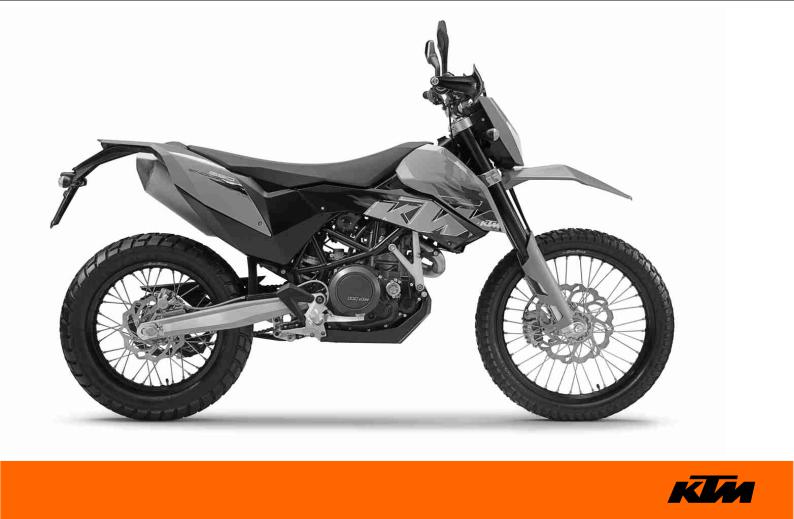
OWNER’S MANUAL 2008
690 ENDURO EU
690 ENDURO AUS/UK
ART. NO. 3211239en

Congratulations on your decision to purchase a KTM motorcycle. You are now the owner of a state-of-the-art sports motorcycle that will give you enormous pleasure if you service and maintain it accordingly.
We wish you great pleasure riding the vehicle!
Enter the serial numbers of your vehicle below.
|
Chassis number ( P. 16) |
Dealer’s stamp |
Engine number (
Key number (
The owner’s manual corresponded to the latest state of this series at the time of printing. However, it is never possible to exclude small deviations arising from further development in design and construction.
All specifications are not binding. KTM Sportmotorcycle AG in particular reserves the right to modify or delete technical specifications, prices, colors, forms, materials, services, designs, equipment, etc., without prior notice and without specifying reasons, to adapt these to local conditions, as well as to stop production of a particular model without prior notice. KTM accepts no liability for delivery options, deviations from illustrations and descriptions, as well as printing and other errors. The models portrayed partly contain special equipment that does not belong to the regular scope of delivery.

© 2008 by KTM-Sportmotorcycle AG, Mattighofen Austria All rights reserved
Reproduction, even in part, is permitted only with the express written permission of the copyright owner.
ISO 9001(12 100 6061)
Within the meaning of the international quality management standard ISO 9001, KTM uses quality assurance processes that lead to the maximum possible quality of the products.
Issued by: TÜV Management Service
KTM-Sportmotorcycle AG
5230 Mattighofen, Austria
|
MEANS OF REPRESENTATION ……………………………………….. |
7 |
|
IMPORTANT NOTES……………………………………………………… |
8 |
|
VIEW OF VEHICLE………………………………………………………. |
12 |
|
View of vehicle, front left side…………………………………….. |
12 |
|
View of vehicle, rear right side ……………………………………. |
14 |
|
LOCATION OF SERIAL NUMBERS ………………………………….. |
16 |
|
Chassis number………………………………………………………. |
16 |
|
Type label……………………………………………………………… |
16 |
|
Key number …………………………………………………………… |
17 |
|
Engine number……………………………………………………….. |
17 |
|
Fork part number…………………………………………………….. |
18 |
|
Shock absorber part number………………………………………. |
18 |
|
OPERATING ELEMENTS………………………………………………. |
19 |
|
Clutch lever …………………………………………………………… |
19 |
|
Hand brake lever …………………………………………………….. |
19 |
|
Light switch …………………………………………………………… |
20 |
|
Light switch …………………………………………………………… |
20 |
|
Headlight flasher switch……………………………………………. |
21 |
|
Flasher switch………………………………………………………… |
21 |
|
Flasher switch………………………………………………………… |
22 |
|
Horn ……………………………………………………………………. |
22 |
|
Horn ……………………………………………………………………. |
23 |
|
Emergency OFF switch……………………………………………… |
23 |
|
Electric starter button ………………………………………………. |
24 |
|
Ignition/steering lock ……………………………………………….. |
24 |
|
Combination instrument……………………………………………. |
25 |
|
Combination instrument — function buttons ……………………. |
25 |
|
Combination instrument — tachometer…………………………… |
26 |
|
Combination instrument — control lamps ……………………….. |
26 |
|
Combination instrument — Display ……………………………….. |
27 |
|
Combination instrument — speed display ……………………….. |
28 |
|
Setting kilometers or miles ………………………………………… |
28 |
|
Combination instrument — time …………………………………… |
29 |
|
Setting the clock …………………………………………………….. |
29 |
|
Combination instrument — ODO display …………………………. |
30 |
|
Combination instrument — setting/resetting TRIP 1 display…. |
30 |
|
Combination instrument — setting/resetting TRIP 2 display…. |
31 |
|
Combination instrument — TRIP F display ………………………. |
32 |
|
Combination instrument — coolant temperature indicator …… |
32 |
|
Opening filler cap……………………………………………………. |
33 |
|
Closing filler cap …………………………………………………….. |
33 |
|
Handrails………………………………………………………………. |
34 |
|
Seat release …………………………………………………………… |
34 |
|
Passenger footrests………………………………………………….. |
35 |
|
Shift lever……………………………………………………………… |
35 |
|
Foot brake pedal …………………………………………………….. |
36 |
|
Side stand …………………………………………………………….. |
37 |
|
GENERAL TIPS AND HINTS ON PUTTING INTO |
|
|
OPERATION………………………………………………………………. |
38 |
|
Advice on first use…………………………………………………… |
38 |
|
Running in the engine………………………………………………. |
40 |
|
Loading the vehicle …………………………………………………. |
40 |
|
RIDING INSTRUCTIONS ………………………………………………. |
42 |
|
Checks before putting into operation ……………………………. |
42 |
|
Starting ………………………………………………………………… |
43 |
|
Starting up ……………………………………………………………. |
45 |
|
Shifting, riding……………………………………………………….. |
45 |
|
Braking ………………………………………………………………… |
48 |
|
Stopping, parking ……………………………………………………. |
49 |
|
Refueling………………………………………………………………. |
51 |
|
GREASING AND SERVICE TABLE …………………………………… |
53 |
|
Important maintenance work to be carried out by an |
|
|
authorized KTM workshop. ………………………………………… |
53 |
|
Important maintenance work to be carried out by an |
|
|
authorized KTM workshop. (as additional order)………………. |
55 |
|
MAINTENANCE WORK ON CHASSIS AND ENGINE…………….. |
56 |
|
Jacking up the motorcycle …………………………………………. |
56 |
|
Removing the motorcycle from the work stand………………… |
56 |
|
Fork/shock absorber…………………………………………………. |
57 |
|
Adjusting compression damping of fork ………………………… |
57 |
|
Adjusting rebound damping of fork………………………………. |
58 |
|
Compression damping of shock absorber……………………….. |
59 |
|
Adjusting the low-speed compression damping of the shock |
|
|
absorber ……………………………………………………………….. |
59 |
|
Adjusting high-speed compression damping of the shock |
|
|
absorber ……………………………………………………………….. |
60 |
|
Adjusting rebound damping of the shock absorber …………… |
62 |
|
Bleeding fork legs……………………………………………………. |
62 |
|
Cleaning dust boots of fork legs ………………………………….. |
63 |
|
Loosening the fork protection……………………………………… |
64 |
|
Positioning the fork protection ……………………………………. |
64 |
|
Checking play of steering head bearing x…………………….. |
65 |
|
Adjusting play of steering head bearing x…………………….. |
66 |
|
Adjusting the handlebar angle x………………………………… |
67 |
|
Handlebar position ………………………………………………….. |
67 |
|
Adjusting handlebar position x…………………………………. |
68 |
|
Checking chain dirt …………………………………………………. |
69 |
|
Cleaning the chain…………………………………………………… |
69 |
|
Checking the chain tension ……………………………………….. |
70 |
|
Adjusting chain tension…………………………………………….. |
71 |
|
Checking rear sprocket / engine sprocket for wear ……………. |
73 |
|
Checking chain wear………………………………………………… |
74 |
|
Adjusting chain guide x………………………………………….. |
75 |
|
Checking brake discs ……………………………………………….. |
75 |
|
Checking free play of hand brake lever………………………….. |
76 |
|
Adjusting free travel of handbrake lever ………………………… |
77 |
|
Checking front brake fluid level…………………………………… |
78 |
|
Adding brake fluid for front brake x……………………………. |
78 |
|
Brake linings………………………………………………………….. |
80 |
|
Checking the front brake linings………………………………….. |
81 |
|
Changing the front brake linings x……………………………… |
81 |
|
Checking free play of foot brake lever …………………………… |
85 |
|
Adjusting basic position of foot brake pedal x………………. |
85 |
|
Checking rear brake fluid level……………………………………. |
86 |
|
Topping up brake fluid of rear brake x………………………… |
87 |
|
Checking the rear brake linings …………………………………… |
89 |
|
Changing rear brake linings x…………………………………… |
89 |
|
Removing front wheel x………………………………………….. |
92 |
|
Fitting front wheel x………………………………………………. |
94 |
|
Removing rear wheel x……………………………………………. |
95 |
|
Fitting rear wheel x……………………………………………….. |
96 |
|
Checking the rear hub rubber dampers x…………………….. |
97 |
|
Tire condition checking…………………………………………….. |
98 |
|
Checking tire air pressure………………………………………… |
100 |
|
Checking spoke tension…………………………………………… |
101 |
|
Removing the seat …………………………………………………. |
102 |
|
Mounting the seat …………………………………………………. |
103 |
|
Removing the battery x…………………………………………. |
103 |
|
Installing the battery x………………………………………….. |
104 |
|
Recharging the battery x……………………………………….. |
105 |
|
Changing the main fuse ………………………………………….. |
107 |
|
Changing fuses of individual power consumers ……………… |
109 |
|
Adjusting the engine characteristic…………………………….. |
111 |
|
Removing headlight mask with headlight …………………….. |
113 |
|
Refitting the headlight mask with the headlight…………….. |
114 |
|
Changing the headlight bulb…………………………………….. |
115 |
|
Changing the parking light bulb ………………………………… |
116 |
|
Changing the flasher bulb ……………………………………….. |
117 |
|
Checking headlamp setting………………………………………. |
118 |
|
Adjusting the headlight range …………………………………… |
119 |
|
Removing the air filter x……………………………………….. |
119 |
|
Installing the air filter x………………………………………… |
120 |
|
Cooling system ……………………………………………………… |
121 |
|
Checking the antifreeze and coolant level ……………………. |
122 |
|
Checking the coolant level……………………………………….. |
124 |
|
Draining coolant x……………………………………………….. |
126 |
|
Filling the cooling system x……………………………………. |
127 |
|
Adjusting basic position of clutch lever……………………….. |
129 |
|
Checking/correcting fluid level of hydraulic clutch …………. |
129 |
|
Checking play in gas Bowden cable ……………………………. |
130 |
|
Adjusting play in gas Bowden cable x……………………….. |
131 |
|
Removing the engine guard ……………………………………… |
132 |
|
Installing the engine guard ………………………………………. |
132 |
|
Checking engine oil level…………………………………………. |
133 |
|
Changing engine oil and oil filter, cleaning oil |
|
|
screens x…………………………………………………………… |
133 |
|
Draining engine oil x……………………………………………. |
134 |
|
Removing the oil filter x………………………………………… |
135 |
|
Mounting oil filter x……………………………………………… |
137 |
|
Cleaning oil screens x…………………………………………… |
137 |
|
Filling up with engine oil x…………………………………….. |
139 |
|
Topping up engine oil …………………………………………….. |
140 |
|
TROUBLESHOOTING…………………………………………………. |
141 |
|
FLASHING CODE ……………………………………………………… |
144 |
|
CLEANING………………………………………………………………. |
147 |
|
Cleaning motorcycle ………………………………………………. |
147 |
|
CONSERVATION FOR WINTER OPERATION ……………………. |
149 |
|
Conservation for winter operation ………………………………. |
149 |
|
STORAGE ……………………………………………………………….. |
150 |
|
Storage……………………………………………………………….. |
150 |
|
Putting into operation after storage ……………………………. |
151 |
|
TECHNICAL DATA — ENGINE……………………………………….. |
152 |
|
Capacity — engine oil ………………………………………………. |
153 |
|
Capacity — coolant………………………………………………….. |
153 |
|
TECHNICAL DATA — ENGINE TIGHTENING TORQUES……….. |
154 |
|
TECHNICAL DATA — CHASSIS ……………………………………… |
157 |
|
Lighting equipment ……………………………………………….. |
158 |
|
Capacity — fuel………………………………………………………. |
159 |
|
TECHNICAL DATA — FORK…………………………………………… |
160 |
|
TECHNICAL DATA — SHOCK ABSORBER ………………………… |
161 |
|
TECHNICAL DATA — CHASSIS TIGHTENING TORQUES ……… |
163 |
|
SUBSTANCES………………………………………………………….. |
166 |
|
AUXILIARY SUBSTANCES…………………………………………… |
169 |

|
CONTENTS |
6 |
|
STANDARDS……………………………………………………………. |
171 |
|
INDEX ……………………………………………………………………. |
172 |
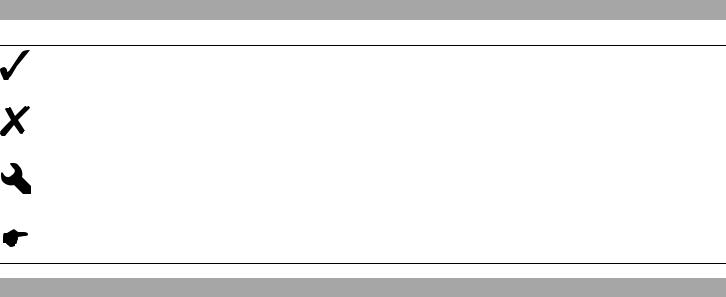
MEANS OF REPRESENTATION |
7 |
Symbols used
The symbols used are explained in the following.
Indicates an expected reaction (e.g. of a work step or a function).
Indicates an unexpected reaction (e.g. of a work step or a function).
All work marked with this symbol requires specialist knowledge and technical understanding. In the interest of your own safety, have these jobs done in an authorized KTM workshop! There, your motorcycle will be serviced optimally by specially trained experts using the specialist tools required.
Identifies a page reference (more information is provided on the specified page).
Formats used
The typographical and other formats used are explained in the following.
|
Eigenname |
Indicates a proprietary name. |
|
Name® |
Identifies a protected name. |
|
Marke™ |
Identifies a brand in merchandise traffic. |
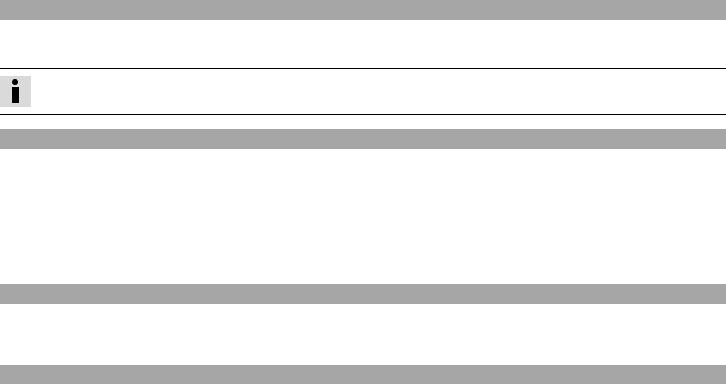
Use definition
KTM sport motorcycles are designed and constructed to meet the normal demands of regular road and light offroad operation (dirt roads), but not for use on race courses.
Info
The motorcycle is authorized for public road traffic in the homologous version only.
Maintenance
A prerequisite for perfect operation and prevention of wear is that the engine and chassis maintenance and adjustment work described in the owner’s manual are properly carried out. Poor adjustment and tuning of the engine and chassis can lead to damage and breakage of components.
Using the motorcycle in extreme conditions such as very muddy or wet roads can lead to above-average wear of components such as the transmission train or the brakes. For this reason, it may be necessary to service or replace worn parts before the limit specified in the greasing and service table is reached.
Pay careful attention to the prescribed running-in period, inspection and maintenance intervals. If you observe these exactly, you will ensure a much longer service life for your motorcycle.
Warranty
The maintenance work prescribed in the greasing and service table must be carried out in an authorized KTM workshop and confirmed in the customer’s service record, since otherwise no warranty claims will be recognized. No warranty claims can be considered for damage resulting from manipulations and/or alterations to the vehicle.
Fuel, oils, etc.
You should use the fuels, oils and greases according to specifications as listed in the owner’s manual.
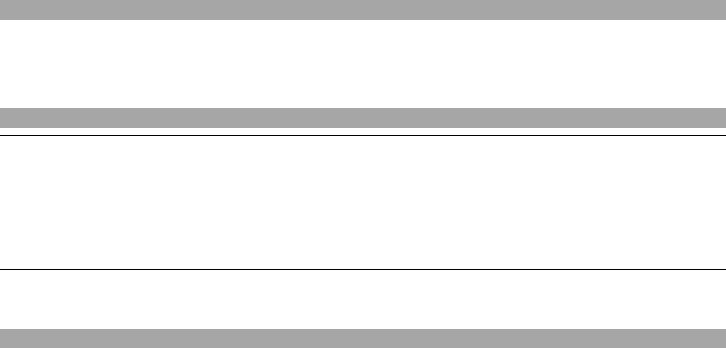
Spare parts, accessories
For your own safety, use only spare parts and accessories approved by KTM, and have these mounted only in an authorized KTM workshop. KTM accepts no liability for other products and any resulting damage or loss.
The current KTM PowerParts for your vehicle can be found on the KTM website.
International KTM Website: http://www.ktm.com
Transport
Note
Danger of damage Danger of damage by the vehicle running away or falling over.
–Always place the vehicle on a firm and even surface.
Note
Fire hazard Some components (engine, radiator and exhaust system) get very hot when the engine is running.
–Do not place the vehicle where there are flammable or explosive substances.
–Switch off the engine and remove the ignition key.
–Use straps or other suitable devices to secure the motorcycle against accidents or falling over.
Environment
Offroad motorcycling is a wonderful sport and we naturally hope that you will be able to enjoy it to the fullest. However, it is a potential problem for the environment and can lead to conflicts with other persons. But if you use your motorcycle responsibly, you can ensure that such problems and conflicts do not have to occur. To protect the future of motorcycle sport, make sure that you use your motorcycle legally, display environmental consciousness, and respect the rights of others.

Notes/warning notes
Pay attention to the specified notes and warnings.
Info
Various notes and warning labels are attached to the vehicle. Do not remove any notes or warning labels. If they are missing, you or others may not recognize dangers and may therefore be injured.
Grades of risks
Danger
Danger that leads immediately and certainly to severe and permanent injury or death.
Warning
Danger that will probably lead to severe and permanent injury or death.
Caution
Danger that could possibly lead to slight injuries.
Note
Danger of serious damage to machine or material.
Warning
Risk of environmental damage.
OWNER’S MANUAL
–Read this owner’s manual carefully and completely before making your first trip. It contains a lot of information and tips to help you operate and handle your motorcycle. Only then will you find out how to customize the motorcycle ideally for your own use and how you can protect yourself from injury. The owner’s manual also contains important information on servicing the motorcycle.
–The owner’s manual is an important component of the motorcycle and should be handed over to the new owner if the vehicle is sold.
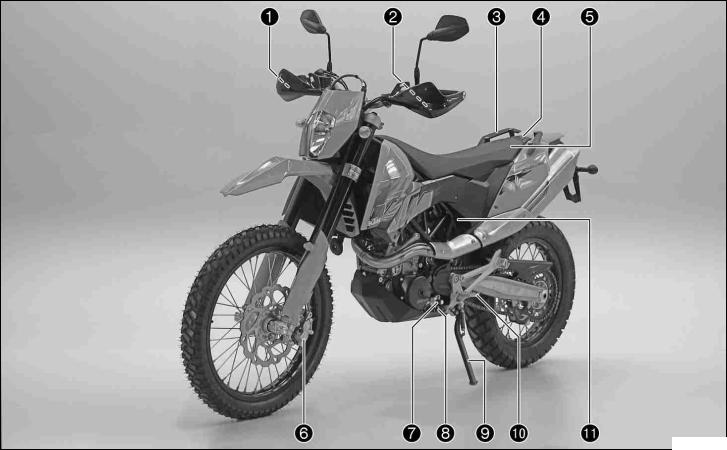
VIEW OF VEHICLE |
12 |
||
|
3View.1 of vehicle, front left side |
100234-10

1Hand brake lever
2Clutch lever
3Handrail
4Filler cap
5Seat
6Front brake caliper
7Shift lever
8Engine number
9Side stand
10Footrest
11Seat release strap
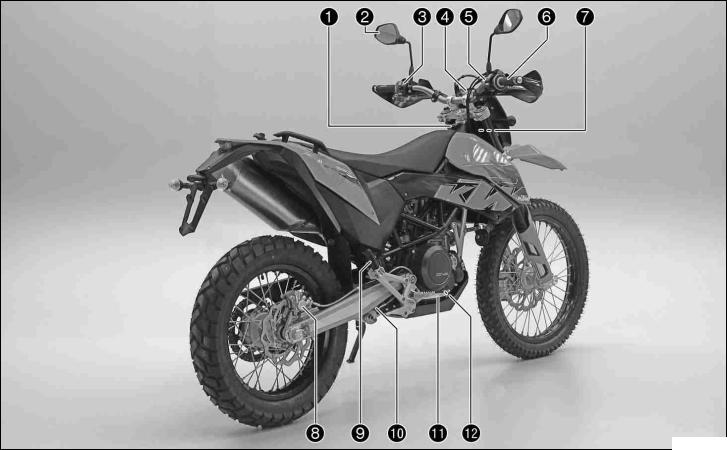
|
VIEW OF VEHICLE |
14 |
||
|
View3.2 of vehicle, rear right side |
|||
100235-10

1Ignition/steering lock
2Rear mirror
3Light switch, flasher switch, horn
4Combination instrument
5Emergency OFF switch, electric starter button
6Throttle grip
7Chassis number
8Rear brake caliper
9Passenger footrest
10Shock absorber rebound damping
11Foot brake pedal
12Engine oil level viewer
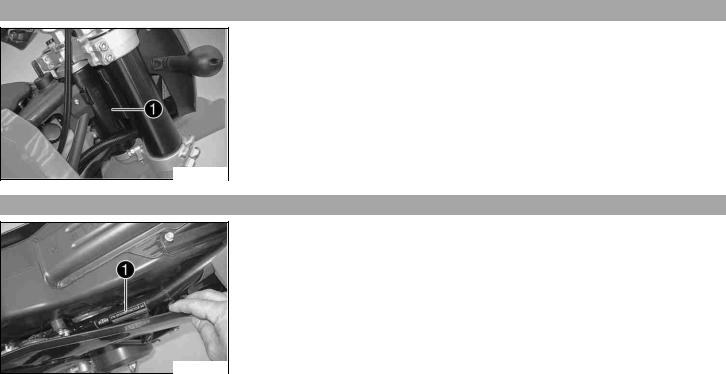
LOCATION OF SERIAL NUMBERS |
16 |
4Chassis.1 number
The chassis number is stamped on the steering head on the right.
100217-10
Type4.2 label
Type label is located on the upper right frame tube below the seat.
100218-10
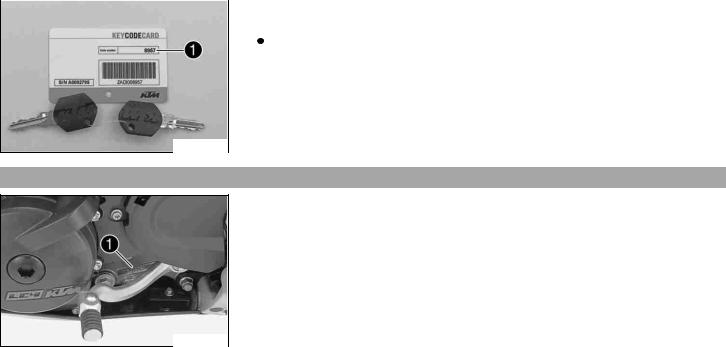
|
LOCATION OF SERIAL NUMBERS |
17 |
|||||||
|
Key4.3 number |
||||||||
|
The key number can be found on the KEYCODECARD. |
||||||||
|
Info |
||||||||
|
You need the key number to order a spare key. Keep the KEYCODECARD in a safe |
||||||||
|
place. |
||||||||
100179-10
Engine4.4 number
The engine number is stamped on the left side of the engine under the engine sprocket.
100211-10
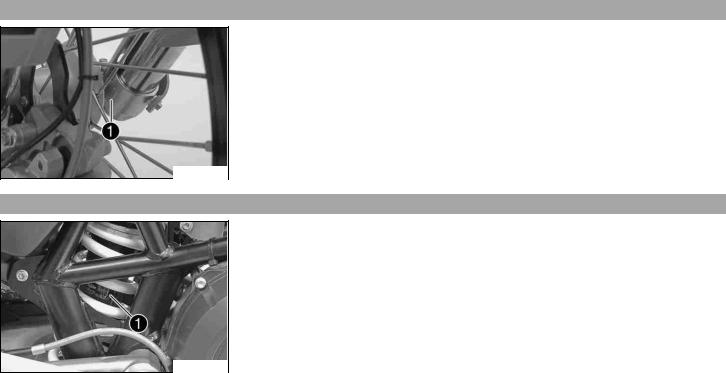
|
LOCATION OF SERIAL NUMBERS |
18 |
Fork4.5 part number
The fork part number is stamped on the inner side of the fork stub.
100214-10
Shock4.6 absorber part number
Shock absorber part number can be viewed from the right side.
100216-10
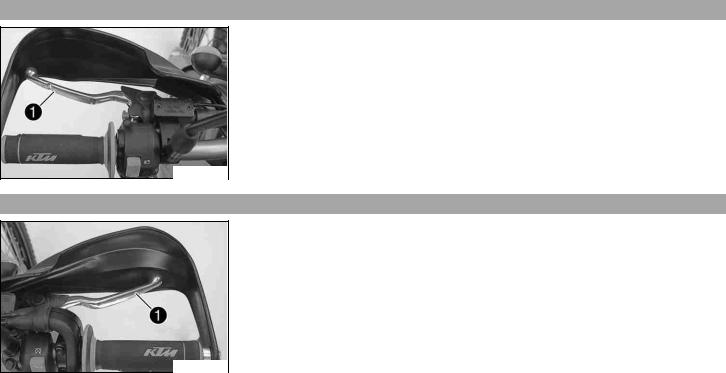
5Clutch.1 lever
The clutch lever is fitted on the left side of the handlebar.
The clutch is hydraulically operated and self-adjusting.
100219-10
Hand5.2 brake lever
The hand break lever is fitted on the right side of the handlebar.
The hand brake lever operates the front brake.
100220-10
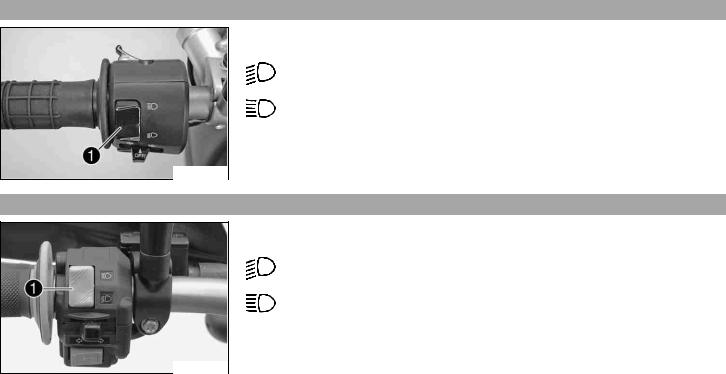
Light5.3 switch
The light switch is fitted on the left side of the handlebar.
Possible states
Low beam on – Light switch is turned downwards. In this position, the low
beam and tail light are switched on.
High beam on – Light switch is turned upwards. In this position, the high beam and the tail light are switched on.
500020-01
Light5.4 switch
The light switch is fitted on the left side of the handlebar.
Possible states
Low beam on – Light switch is turned downwards. In this position, the low
beam and tail light are switched on.
High beam on – Light switch is turned upwards. In this position, the high beam and the tail light are switched on.
100222-10
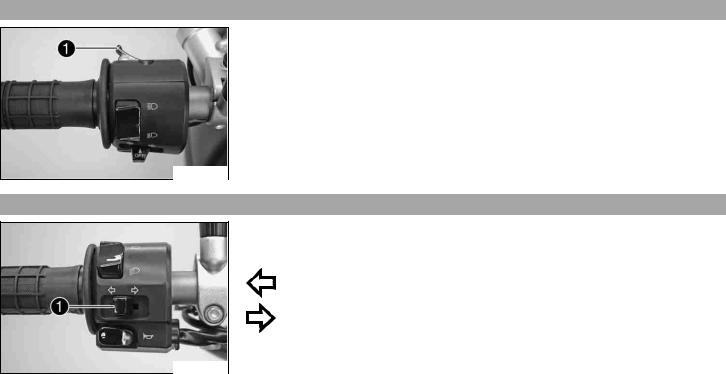
Headlight5.5 flasher switch
The headlight flasher switch is fitted on the left side of the handlebar.
Possible states
•Headlight flasher switch in neutral position
•Headlight flasher switch pressed – In this position, the headlight flasher (high beam) is actuated.
500020-11
Flasher5.6 switch
The flasher switch is fitted on the left side of the handlebar.
Possible states
Flasher light off
Flasher light, left, on – Flasher switch pressed to the right. The flasher switch returns automatically to the central position after use.
Flasher light, right, on – Flasher switch pressed to the right. The flasher switch returns automatically to the central position after use.
To switch off the flasher light, press the flasher switch towards the switch case.
500021-10
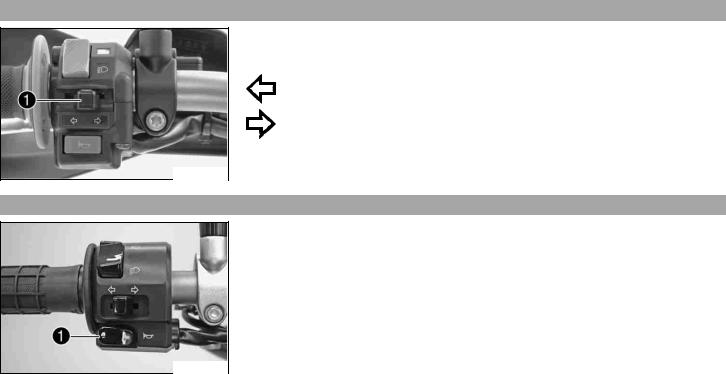
Flasher5.7 switch
The flasher switch is fitted on the left side of the handlebar.
Possible states
Flasher light off
Flasher light, left, on – Flasher switch pressed to the right. The flasher switch returns automatically to the central position after use.
Flasher light, right, on – Flasher switch pressed to the right. The flasher switch returns automatically to the central position after use.
To switch off the flasher light, press the flasher switch towards the switch case.
100223-10
Horn5.8
The horn button is fitted on the left side of the handlebar.
Possible states
•Horn button 
•Horn button 
500021-11
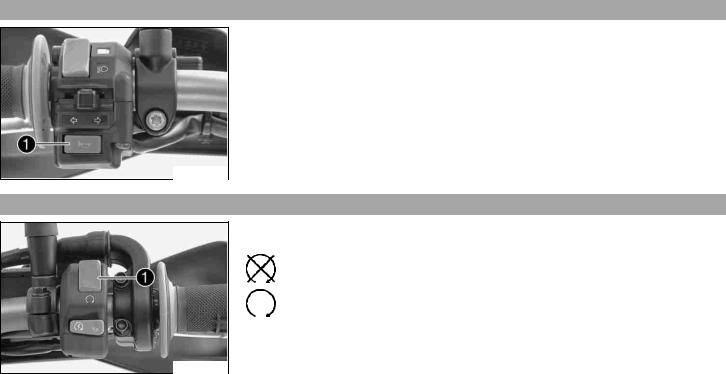
Horn5.9
The horn button is fitted on the left side of the handlebar.
Possible states
•Horn button 
•Horn button 
100224-10
Emergency5.10 OFF switch
The emergency OFF switch is fitted on the left side of the handlebar.
Possible states
Emergency OFF switch off – In this position, the ignition circuit is interrupted, a running engine stops, and the engine cannot be started.
Emergency OFF switch on – This position is necessary for operation as the ignition circuit is closed.
100225-10
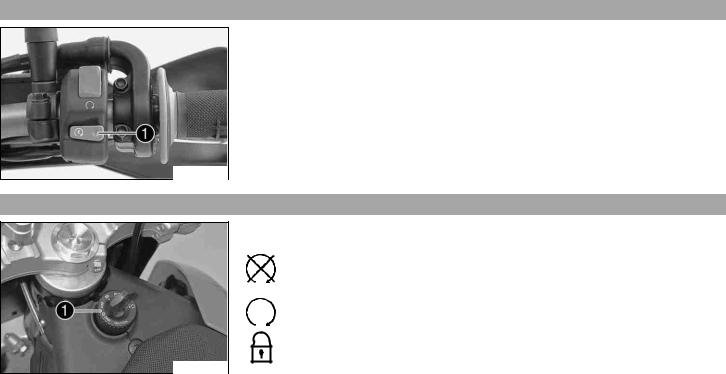
Electric5.11 starter button
The electric starter button is fitted on the right side of the handlebar.
Possible states
•Electric starter button  in basic position
in basic position
•Electric starter button 
100226-10
Ignition/steering5.12 lock
The ignition/steering lock is located in front of the seat.
Possible states
Ignition off – In this position, the ignition circuit is interrupted, a running engine stops, and a non-running engine will not start. The ignition key can be removed.
Ignition on – In this position, the ignition circuit is closed, and the engine can be started.
Steering locked – In this position, the ignition circuit is interrupted and the steering locked. The ignition key can be removed.
100221-10
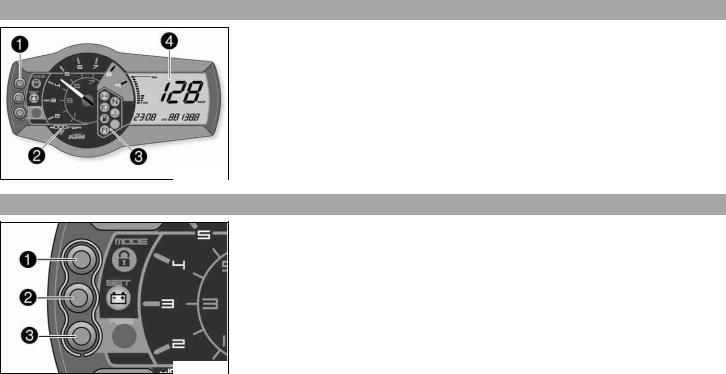
Combination5.13 instrument
The combination instrument is attached in fromt of the handlebar. The combination instrument is divided into 4 function areas.
Function buttonsTachometer
Indicator lightsDisplay
700116-01
Combination5.14 instrument — function buttons
Press the MODE button to change the display mode.
Possible display modes are total distance covered (ODO), tripmaster 1 (TRIP 1) and tripmaster 2 (TRIP 2).
Press the SET button to reset tripmaster 1 (TRIP 1) and tripmaster 2 (TRIP 2) to 0.0. Button has no function.
700117-01
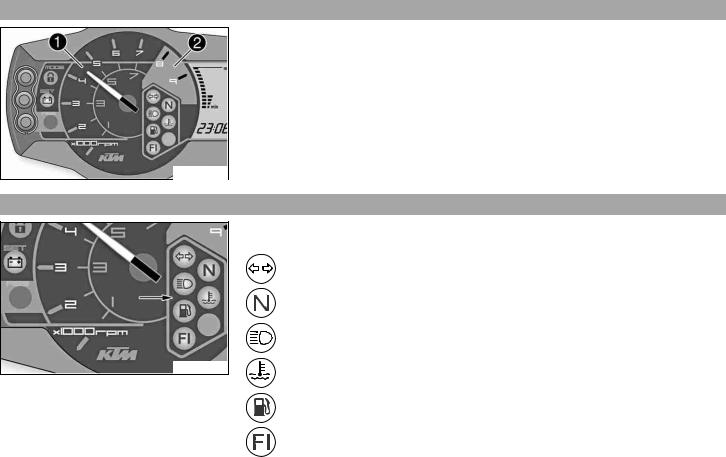
Combination5.15 instrument — tachometer
The tachometer displays the engine speed in revolutions per minute.
The red marking shows the excess engine speed range.
100118-10
Combination5.16 instrument — control lamps
100119-10
The indicator lamps provide additional information on the operating state of the motorcycle.
Possible states
Flashing indicator flashes green in flash rhythm – Flasher light is switched on.
Idling speed indicator lamp lights up green – Transmission is in neutral.
High beam indicator lamp lights up blue – High beam is switched on.
Temperature warning lamp lights up red – Coolant has reached a critical value.
Fuel level warning lamp lights up orange – Fuel level has reached the reserve mark. Display switches to TRIP F.
FI warning lamp (MIL) lights/flashes orange – The OBD has detected an emissionor safety-critical error.
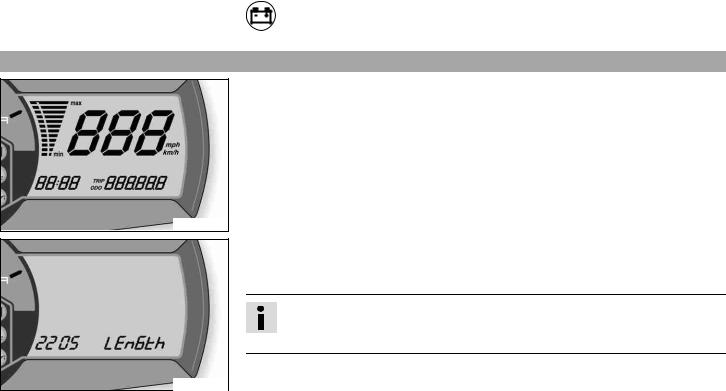
Combination5.17 instrument — Display
700118-01
400404-01
Battery warning lamp lights up – Voltage in electrical system too low.
When you switch on the ignition, all display segments light up for a second as a function test.
LEnGTth
Following the display function test, the wheel circumference LEnGth is shown for one second.
Info
2205 mm equals the circumference of the 21″ front wheel with a series production tire.
The display then changes to the last selected mode.
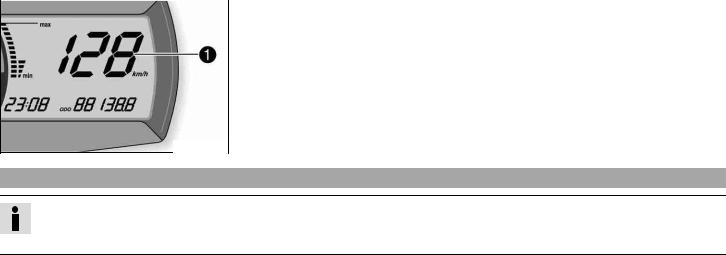
|
OPERATING ELEMENTS |
28 |
||||
|
Combination5.18 |
instrument — speed display |
||||
|
The speed is displayed in kilometers per hour km/h or miles per hour Mph. |
|||||
700114-01
Setting5.19 kilometers or miles
Info
If you change the unit, the ODO value is retained and converted accordingly.
Making the setting according to the country.
Condition
The motorcycle is standing.

–Switch on the ignition by turning the ignition key in the position 
–Press the MODE button several times until the ODO display mode is active.
–Keep the MODE button pressed until the display mode changes from Km/h to Mph or from Mph to Km/h.
Specification
|
Activation duration of MODE button |
10 s |
700120-01
Combination5.20 instrument — time
The time is shown in area of the display.
Info
The time must be adjusted after the battery is disconnected or the fuse is changed.
700115-01
Setting5.21 the clock
Condition
The motorcycle is standing.

–Switch on the ignition by turning the ignition key in the position 
–Press the MODE button several times until the ODO display mode is active.
–Keep the MODE button and the SET button pressed simultaneously.

–Press the MODE button to adjust the hour.
–Press the SET button to adjust the minute.
–Keep the MODE button and the SET button pressed simultaneously.
|
The time is set. |
||
|
700115-10 |
||
Combination5.22 instrument — ODO display
In ODO mode, the total distance covered is shown in kilometers or miles.
Info
This value remains intact even if the battery is disconnected and/or the fuse blows.
700120-01
Combination5.23 instrument — setting/resetting TRIP 1 display
Info
The tripmaster TRIP 1 operates constantly and counts up to 999.9.
You can use the tripmaster to measure trips or the distance between refuelling stops. After reaching 999.9, the tripmaster begins again at 0.0.

|
OPERATING ELEMENTS |
31 |
||
|
– |
Switch on the ignition by turning the ignition key in the position . |
||
|
– Press the MODE button several times until the TRIP 1 display mode is active. |
|||
|
– Keep the SET button pressed. |
|||
|
The TRIP 1 display is at 0.0. |
700121-01
Combination5.24 instrument — setting/resetting TRIP 2 display
Info
The tripmaster TRIP 2 operates constantly and counts up to 999.9.
You can use the tripmaster to measure trips or the distance between refuelling stops. After reaching 999.9, the tripmaster begins again at 0.0.
–Switch on the ignition by turning the ignition key in the position 
–Press the MODE button several times until the TRIP 2 display mode is active.
–Keep the SET button pressed.

700122-01

Combination5.25 instrument — TRIP F display
When the fuel level reaches the reserve mark, the display automatically changes to TRIP F and begins to count from 0.0, regardless of which display mode was previously active.
Info
Parallel to the TRIP F display, the fuel warning light begins to light up.
700123-01
Combination5.26 instrument — coolant temperature indicator
The temperature indicator in the display consists of 12 bars. The more bars that light up, the hotter the coolant. When the top bar lights up, all bars begin to flash simultaneously and the temperature warning lamp begins to light up.
Possible states
•Engine cold – up to four bars light up.
•Engine at normal operating temperature – from five to eleven bars light up.
•Engine hot – all twelve bars flash.
700124-01

Opening5.27 filler cap
–Lift the cover of the filler cap and insert the ignition key.
–Turn the ignition key 90° counterclockwise and remove the filler cap.
Info
The filler cap has a tank air vent system.
100227-10
Closing5.28 filler cap
–Put the filler cap back on and turn the ignition key 90° clockwise.
–Remove the ignition key and fold down the cover.
100228-01

Handrails5.29
The handrails are used for moving the motorcycle around.
When you have a passenger, the passenger can hold on the handrails during the journey.
100229-10
Seat5.30 release
The seat can be released using strap .
100230-10

Passenger5.31 footrests
The passenger footrests can be folded up and down.
Possible states
•Passenger footrests folded up – For operation without a passenger.
•Passenger footrests folded down – For operation with a passenger.
100231-01
Shift5.32 lever
The shift lever is mounted on the left side of the engine.
100215-10

The gear positions can be seen in the photograph.
The neutral or idle position is between the first and second gears.
100212-10
Foot5.33 brake pedal
The footbrake pedal is located in front of the right footrest.
The footbrake pedal operates the rear brake.
100232-10

|
OPERATING ELEMENTS |
37 |
||
|
Side5.34 stand |
|||
|
The side stand is coupled with the safety electric starter system — see the riding instruc- |
|||
|
tions. |
Possible states
•Side stand folded out – The vehicle can be supported on the side stand. The safety electric starter system is active.
•Side stand folded in – This position is mandatory for all journeys. The safety electric starter system is inactive.
100233-10

GENERAL TIPS AND HINTS ON PUTTING INTO OPERATION |
38 |
6Advice.1 on first use
Danger
Danger of accidents Danger from inadequate traffic experience.
–Do not use the vehicle if you are inexperienced or if you have consumed alcohol or drugs.
Warning
Risk of injury Risk of injury by missing/inadequate protective clothing.
–Wear protective clothing (helmet, boots, gloves, pants and jacket with protectors) every time you ride the motorcycle. Always wear protective clothing, which must be in perfect condition and meet legal requirements.
Warning
Danger of crashing Impairment of riding behavior due to different tire tread patterns on front and rear wheels.
–The front and rear wheels must be fitted with tires with similar tread patterns to prevent loss of control over the vehicle.
Warning
Danger of accidents Uncontrollable handling behavior caused by non-approved tires/wheels.
–Use only tires/wheels approved by KTM with the corresponding speed index.
Warning
Danger of accidents Reduced road grip with new tires.
–New tires have a smooth roll surface and therefore cannot provide full road grip. The entire roll surface must be roughened in the first 200 kilometers (124.3 miles) by moderate driving at alternating angles. The full grip is not reached until the vehicle has been run in.
Warning
Danger of accidents Brake system failure.
–If the foot brake pedal is not released, the brake linings drag permanently. The rear brake can fail due to overheating. Take your foot off the foot brake pedal if you do not want to brake.

|
GENERAL TIPS AND HINTS ON PUTTING INTO OPERATION |
39 |
Info
When using your vehicle, remember that others may feel disturbed by excessive noise.
–Make sure that the pre-delivery inspection work has been carried out by an authorized KTM workshop. You receive a delivery certificate and the service record at vehicle handover.
–Before your first trip, read the entire operating instructions carefully.
–Get to know the operating elements.
–adjust the basic position of clutch lever. (
–Adjust the free travel of the handbrake lever. (
–Adjust the basic position of the foot brake pedal. x(
–Get used to handling the vehicle on a car park before making a longer trip. Try also to ride as slowly as possible and in a standing position to get a better feeling for the vehicle.
–Do not make any offroad trips that over-stress your ability and experience.
–Hold the handlebar firmly with both hands and keep your feet on the footrests when riding.
–Do not make any changes to the vehicle, and use only KTM approved parts.
Info
Parts from other manufacturers can reduce the operational safety of the vehicle.
–Run the engine in.

|
GENERAL TIPS AND HINTS ON PUTTING INTO OPERATION |
40 |
Running6.2 in the engine
–During the running-in phase, do not exceed the specified engine speed and engine performance. Specification
Maximum engine speed
|
During the first: 1,000 km (621.4 mi) |
6,000 rpm |
|
After the first: 1,000 km (621.4 mi) |
7,800 rpm |
– Avoid fully opening the throttle!
Loading6.3 the vehicle
Warning
Danger of accidents Unstable riding behavior.
–Do not exceed the maximum permitted weight and axle loads. The overall weight consists of: motorcycle operational and with a full tank, driver and passenger with protective clothing and helmet, baggage.
Warning
Danger of accidents Unstable handling characteristics due to incorrect mounting of suitcase and/or tank rucksack.
–Mount and secure suitcase and tank rucksack according to the manufacturer’s instructions.
Warning
Danger of accidents Unstable handling characteristics at high speed.
–Adapt your speed according to your payload. Ride more slowly if your motorcycle is loaded with cases or other baggage.
|
Maximum speed with baggage |
130 km/h (80.8 mph) |
Warning
Danger of accidents Risk of breakage of suitcase system.
–If you have fitted suitcases on your motorcycle, read the manufacturer’s specifications concerning the maximum payload.

|
GENERAL TIPS AND HINTS ON PUTTING INTO OPERATION |
41 |
Warning
Danger of accidents Poor visibility for other road users due to slipped baggage.
–If the tail light is covered, you are less visible to following traffic, especially in the dark. Check the way your baggage is fixed regularly.
Warning
Danger of accidents Changed handling characteristics and longer stopping distance with excessive payload.
–Adapt your speed according to your payload.
Warning
Danger of accidents Unstable handling characteristics due to slipped baggage.
–Check the way your baggage is fixed regularly.
Warning
Danger of burns A hot exhaust system can burn baggage.
–Fasten your baggage in such a way that it cannot be burned or singed by the hot exhaust system.
–If you carry any baggage, make sure it is fixed firmly as close as possible to the center of the vehicle and ensure even weight distribution between the front and rear wheels.
–Do not exceed the overall maximum permitted weight and the axle loads. Specification
|
Maximum permissible overall weight |
350 kg (772 lb.) |
|
Maximum permissible front axle load |
150 kg (331 lb.) |
|
Maximum permissible rear axle load |
200 kg (441 lb.) |

7Checks.1 before putting into operation
Info
Make sure that the motorcycle is in a perfect technical condition before use.
In the interests of riding safety, make a habit of making a general check before you ride.
–Check the engine oil level. (
–Check the engine for loss of oil.
–Check the fuel level.
–Bleed fork legs. (
–Check the chain tension. (
–Clean the chain. (
–Check the tire condition. (
–Checking the tire air pressure. (
–Check the front brake brake fluid level. (
–Check the rear brake fluid level. (
–Check the front brake linings. (
–Check the rear brake linings. (
–Check brake system function.
–Check the coolant level. (
–Check that all operating elements are correctly adjusted and free to move.
–Check the functioning of the electrical equipment.
–Check that baggage is correctly secured.
–Sit on the motorcycle and check the rear mirror setting.

Starting7.2
Danger
Danger of poisoning Exhaust gases are poisonous and can result in unconsciousness and/or death.
–When running the engine, always make sure there is sufficient ventilation, and do not start or run the engine in a closed space.
Caution
Danger of accidents If the vehicle is operated with a discharged battery or without a battery, electronic components and safety equipment may be damaged.
–Never operate the vehicle with a discharged battery or without a battery.
Note
Engine failure High engine speeds in cold engines have a negative effect on the service life of the engine.
–Always warm up the engine at low engine speeds.

|
RIDING INSTRUCTIONS |
44 |
||||||
|
– |
Turn the emergency OFF switch to the position . |
||||||
|
– |
Switch on the ignition by turning the ignition key in the position . |
||||||
|
After switching on the ignition, you can hear the fuel pump working for about 2 |
|||||||
|
seconds. At the same time, the combination instrument runs a function test. |
|||||||
|
– Shift gear to neutral. |
|||||||
|
The green idling speed indicator lamp N lights up. |
|||||||
|
– |
Press the electric starter button . |
||||||
|
Info |
|||||||
|
Do not press the electric starter button until the combination instrument func- |
|||||||
|
tion test is finished. |
|||||||
|
Do not open the throttle when starting. If you open the throttle when starting, |
|||||||
|
the engine management injects no fuel and the engine cannot start. |
|||||||
|
Press the starter for a maximum of 5 seconds. Wait for at least 5 seconds until |
|||||||
|
trying again. |
|||||||
|
This motorcycle is equipped with a safety electric starter system. The engine |
|||||||
|
can be started only if the gearbox is in neutral or the clutch lever is pulled. If |
|||||||
|
you shift into gear when the side stand is folded out and then release the clutch |
|||||||
|
lever, the engine stalls. |
|||||||
|
– Take the weight off the side stand and swing it back up with your foot as far as it will |
|||||||
|
go. |
100239-10

Starting7.3 up
–Pull the clutch lever, engage 1st gear, release the clutch lever slowly and simultaneously open the throttle carefully.
Shifting,7.4 riding
Warning
Danger of accidents An abrupt load alterations can cause the vehicle to get out of control.
–Avoid abrupt load alterations and sudden braking actions, and adapt your speed to the road conditions.
Warning
Danger of accidents If you change down at high engine speed, the rear wheel can lock up.
–Do not change into a low gear at high engine speed. The engine races and the rear wheel can block.
Warning
Danger of accidents Malfunctions caused by incorrect ignition key position.
–Do not change the ignition key position during a journey.
Warning
Danger of accidents Distraction from traffic activity by adjustments to the vehicle.
–Make all adjustments when the vehicle is at a standstill.
Warning
Risk of injury The passenger must be capable of sitting correctly on the passenger seat.
–The passenger must hold on to the rider or the handrails and place his feet on the passenger footrests. Note the regulations governing the minimum age of passengers in your country.
Warning
Danger of accidents Danger of accidents caused by dangerous driving.
–Observe the traffic regulations and ride defensively and with foresight in order to recognize danger as early as possible.

Warning
Danger of accidents Reduced road grip with cold tires.
–On every journey, take the first miles carefully at moderate speed until the tires reach operating temperature and optimal road grip is ensured.
Warning
Danger of accidents Reduced road grip with new tires.
–New tires have a smooth roll surface and therefore cannot provide full road grip. The entire roll surface must be roughened in the first 200 kilometers (124.3 miles) by moderate driving at alternating angles. The full grip is not reached until the vehicle has been run in.
Warning
Danger of accidents Unstable riding behavior.
–Do not exceed the maximum permitted weight and axle loads. The overall weight consists of: motorcycle operational and with a full tank, driver and passenger with protective clothing and helmet, baggage.
Warning
Danger of accidents Unstable handling characteristics due to slipped baggage.
–Check the way your baggage is fixed regularly.
Warning
Danger of accidents After a fall, check the vehicle.
–After a fall, check the vehicle as usual before putting it into operation.
Note
Engine failure Unfiltered intake air has a negative effect on the service life of the engine.
–Never ride the vehicle without an air filter since dust and dirt can get into the engine and result in increased wear.

Note
Engine failure Overheating of engine.
–If the coolant temperature warning lamp lights up, stop and switch off the engine. Allow the engine to cool down and check the coolant level in the radiator, and top up if necessary. If you continue with the coolant temperature warning lamp alight, you may have engine failure.
Info
If you hear unusual noises while riding, stop immediately, switch off the engine and contact an authorized KTM workshop.
–When conditions allow (incline, road situation, etc.), you can shift into a higher gear.
–Release the throttle while simultaneously pulling the clutch lever, shift into the next gear, release the clutch and open the throttle.
|
Info |
|||||
|
For the positions of the 6 forward gears, see the illustration. The neutral or idle |
|||||
|
position is between the first and second gears. First gear is used for starting off |
|||||
|
or for steep inclines. |
|||||
|
The operating temperature is reached when 5 bars of the temperature indicator |
|||||
|
light up. |
|||||
|
100212-10 |
|||||
–When you reach maximum speed after fully opening the throttle, turn back the throttle to about ¾ of its range; the speed hardly drops, but the fuel consumption falls considerably.
–Open the throttle only as far as the road and weather conditions permit. Particularly in bends, do not shift and open the throttle only very cautiously.
–To shift down, brake if necessary and close the throttle at the same time.
–Pull the clutch lever and shift into a lower gear, release the clutch lever slowly and open the throttle or shift again.

|
RIDING INSTRUCTIONS |
48 |
||||||
|
– For example, if the engine stalls at a junction, just pull the clutch and press the electric |
|||||||
|
starter button. You do not need to shift into neutral. |
|||||||
|
– Switch off the engine if you expect to be standing for a long time. |
|||||||
|
– Avoid frequent and longer slipping of the clutch. This heats the engine oil, the engine |
|||||||
|
and the cooling system. |
|||||||
|
– Ride with a lower engine speed instead of with a high engine speed and a slipping |
|||||||
|
clutch. |
|||||||
|
– If the FI warning lamp (MIL) starts to light up during the journey, stop immediately. If |
|||||||
|
you shift to neutral, the FI warning lamp (MIL) begins to flash. |
|||||||
|
Info |
|||||||
|
From the flash rhythm, you can deduce a two-digit number, the so-called flash |
|||||||
|
code. The flash code tells you which component is affected by a fault. |
|||||||
Braking7.5 |
|||||||
|
Warning |
Danger of accidents If you brake too hard, the wheels can lock.
–Adapt your braking to the traffic situation and the road conditions.
Warning
Danger of accidents Reduced braking due to wet or dirty brakes.
–Clean or dry dirty or wet brakes by riding and braking gently.
Warning
Danger of accidents Reduced braking caused by spongy pressure point of front or rear brake.
–Have the brake system checked in an authorized KTM workshop, and do not ride any further.



 in basic position
in basic position